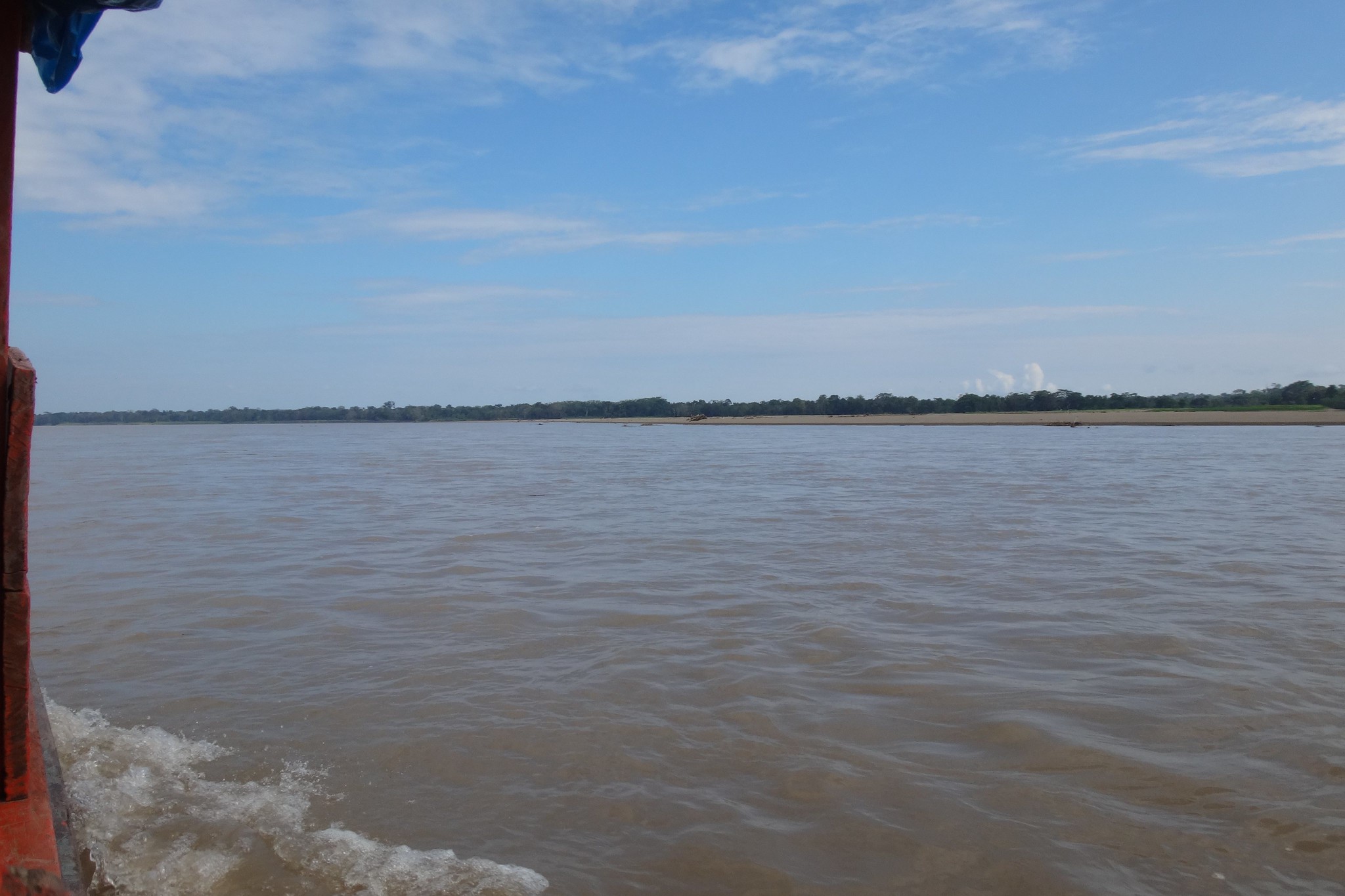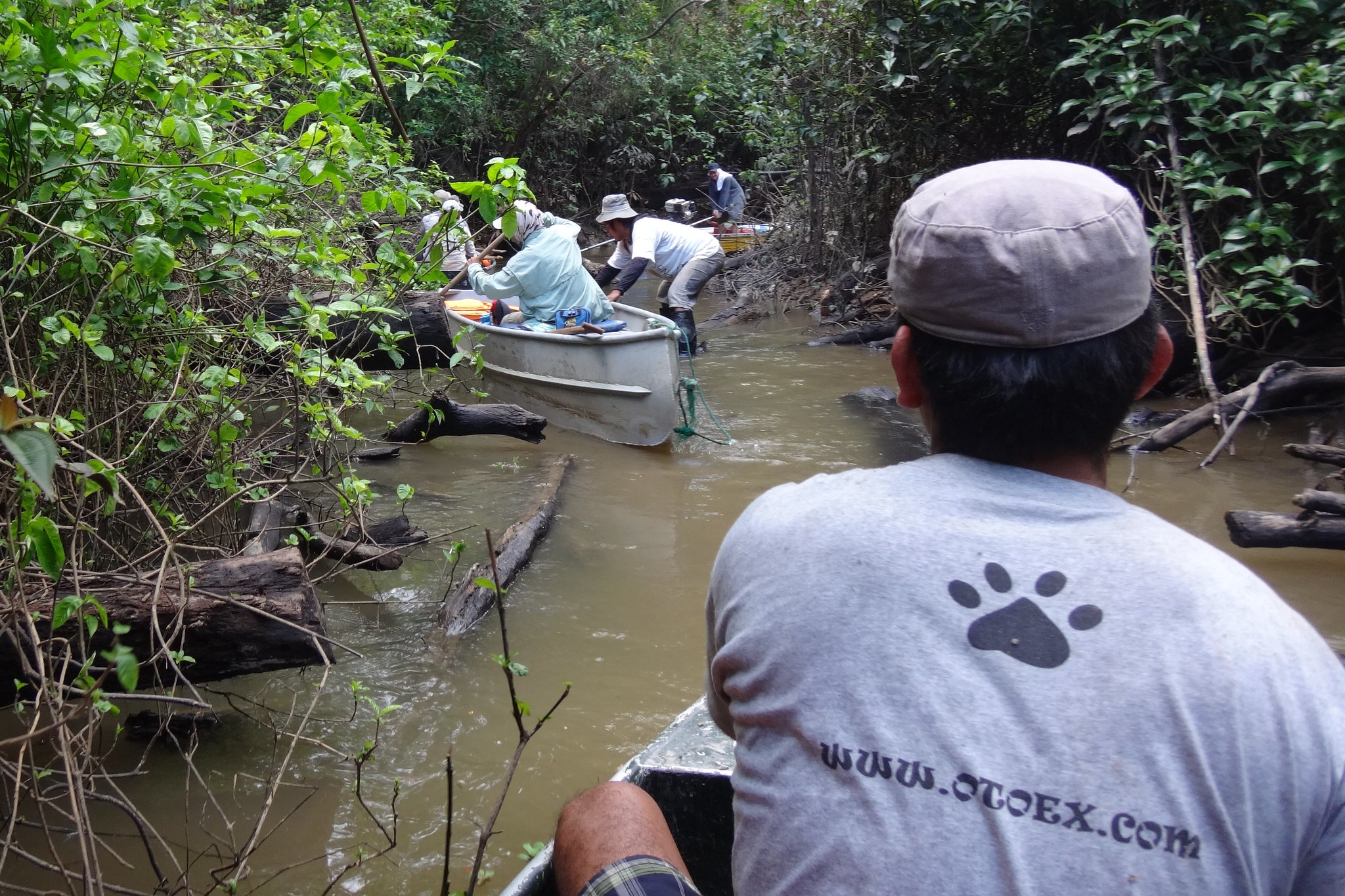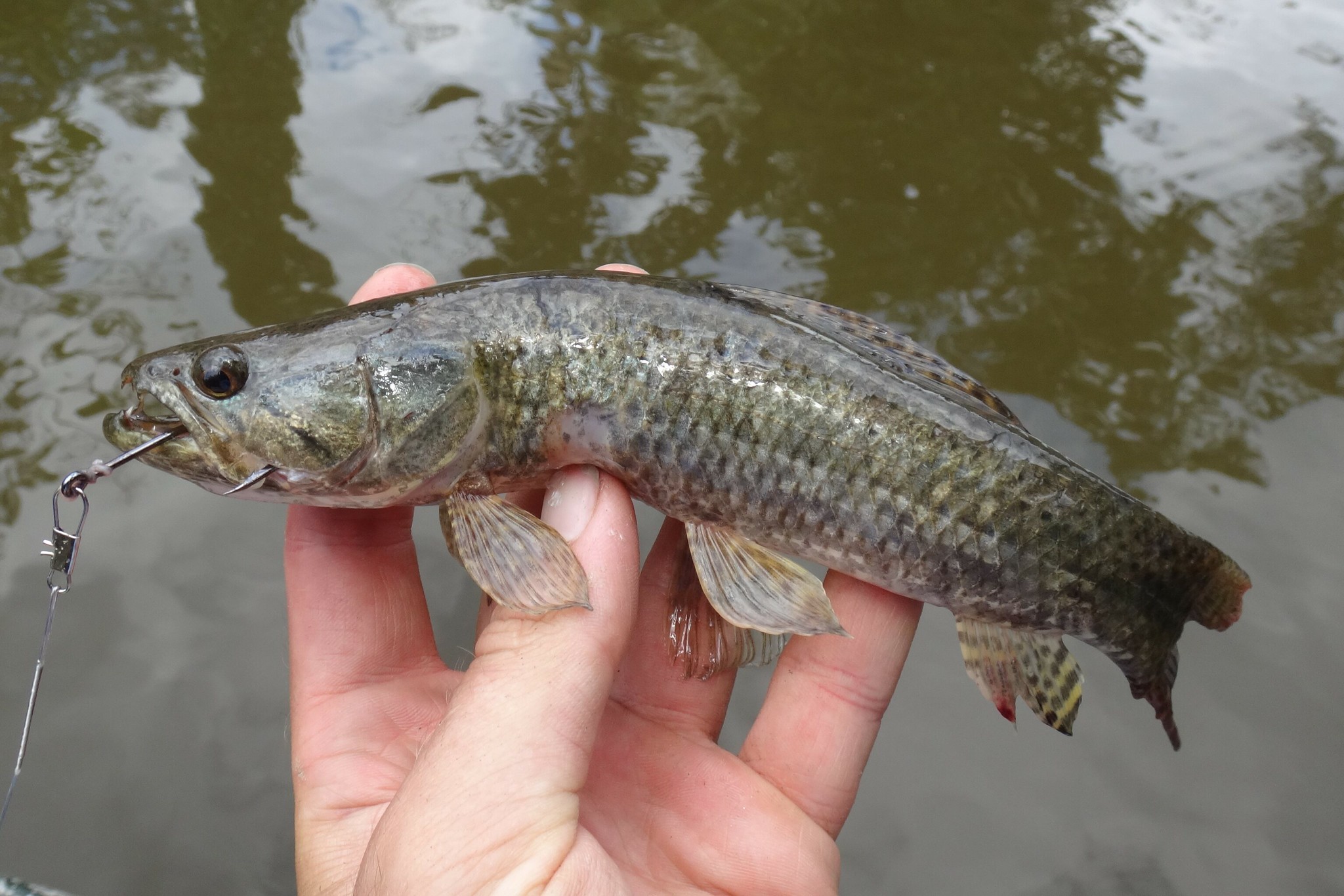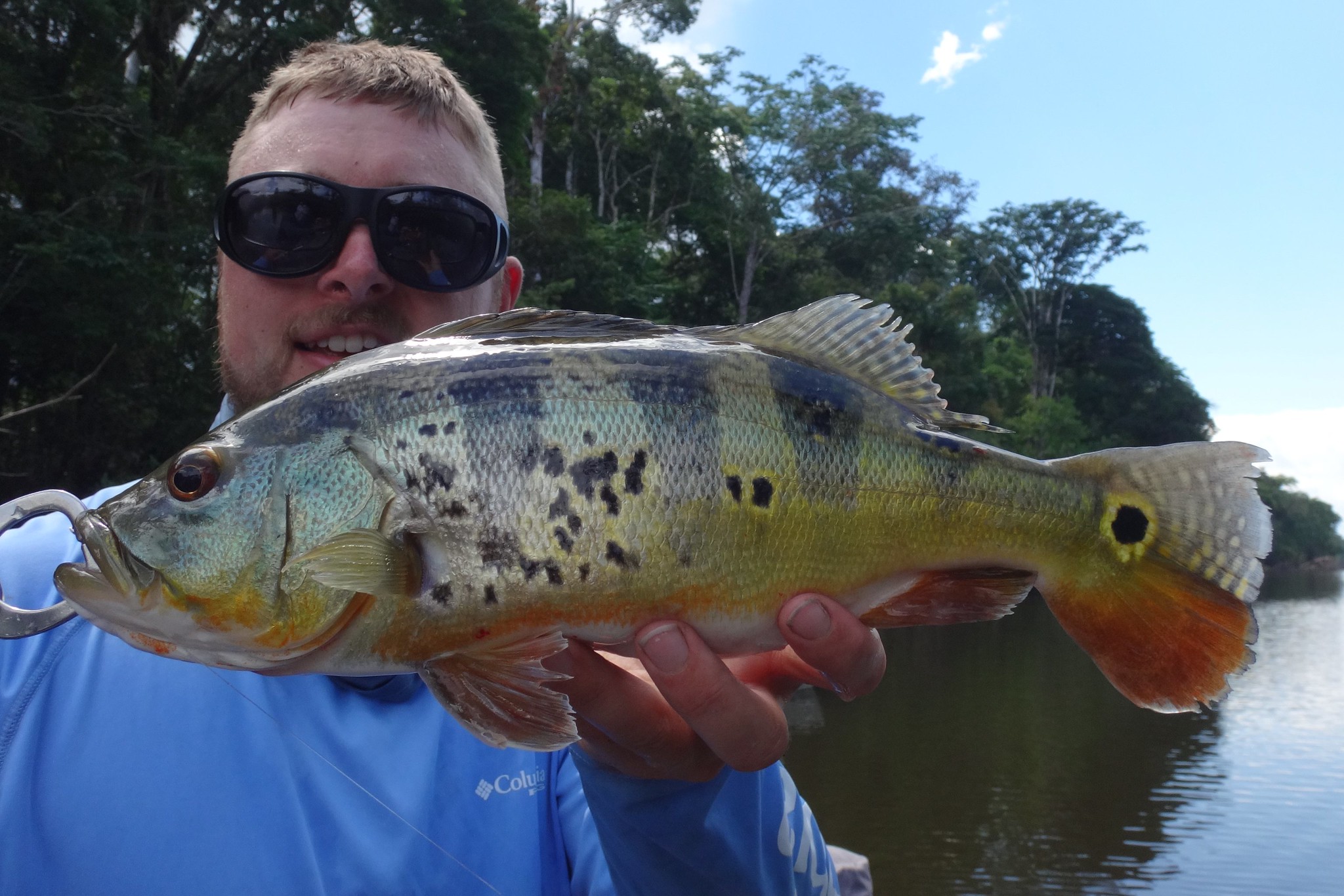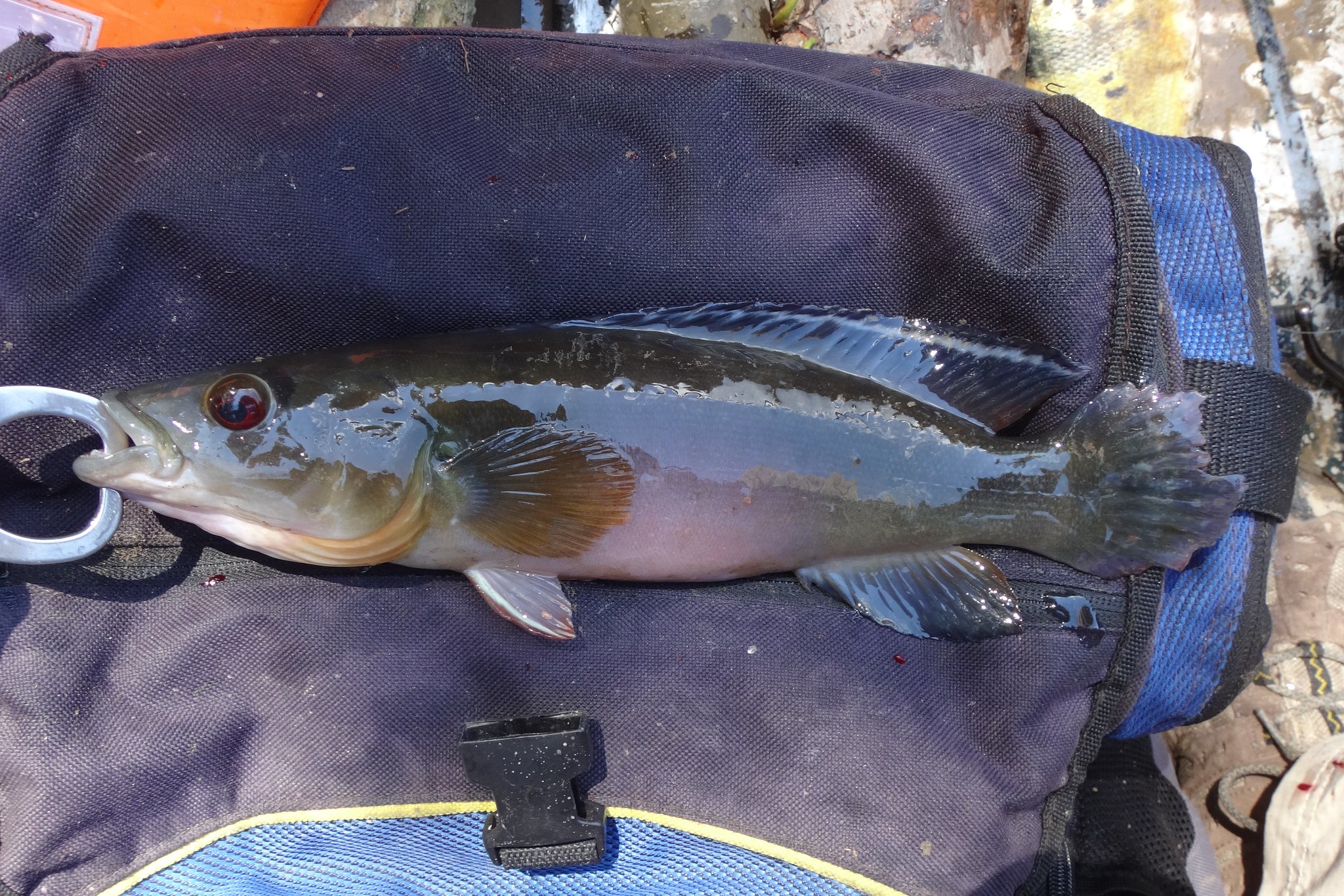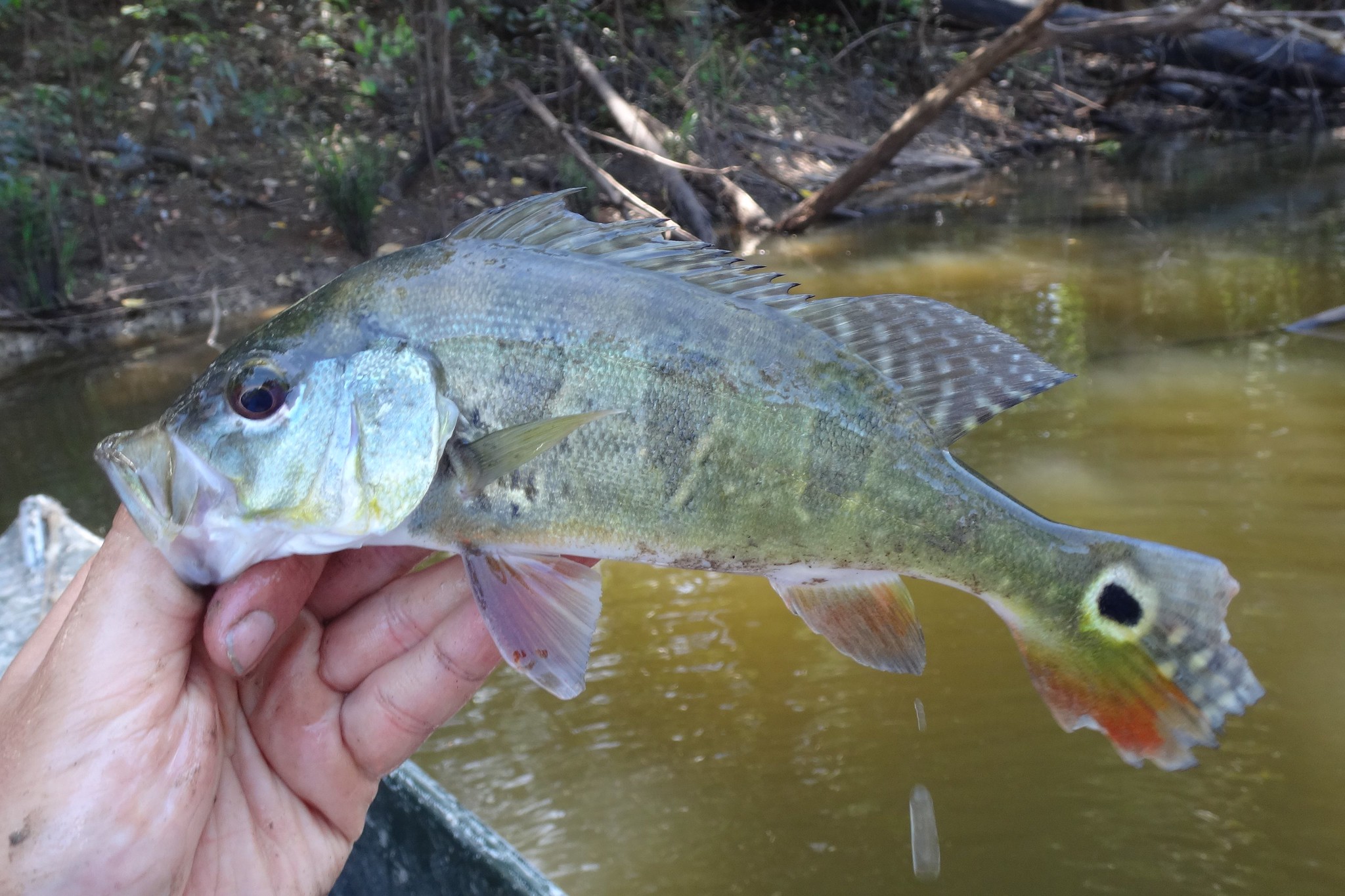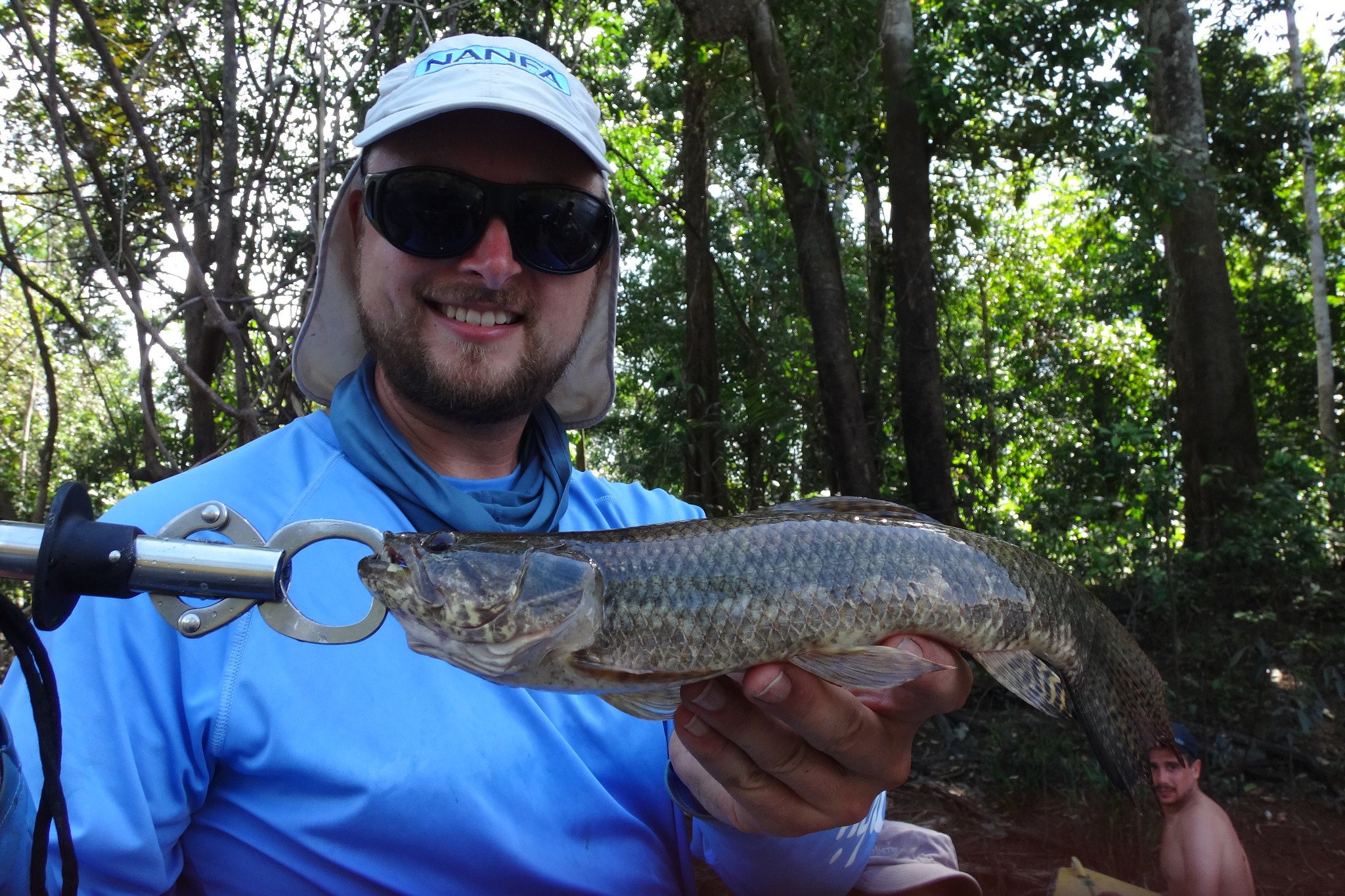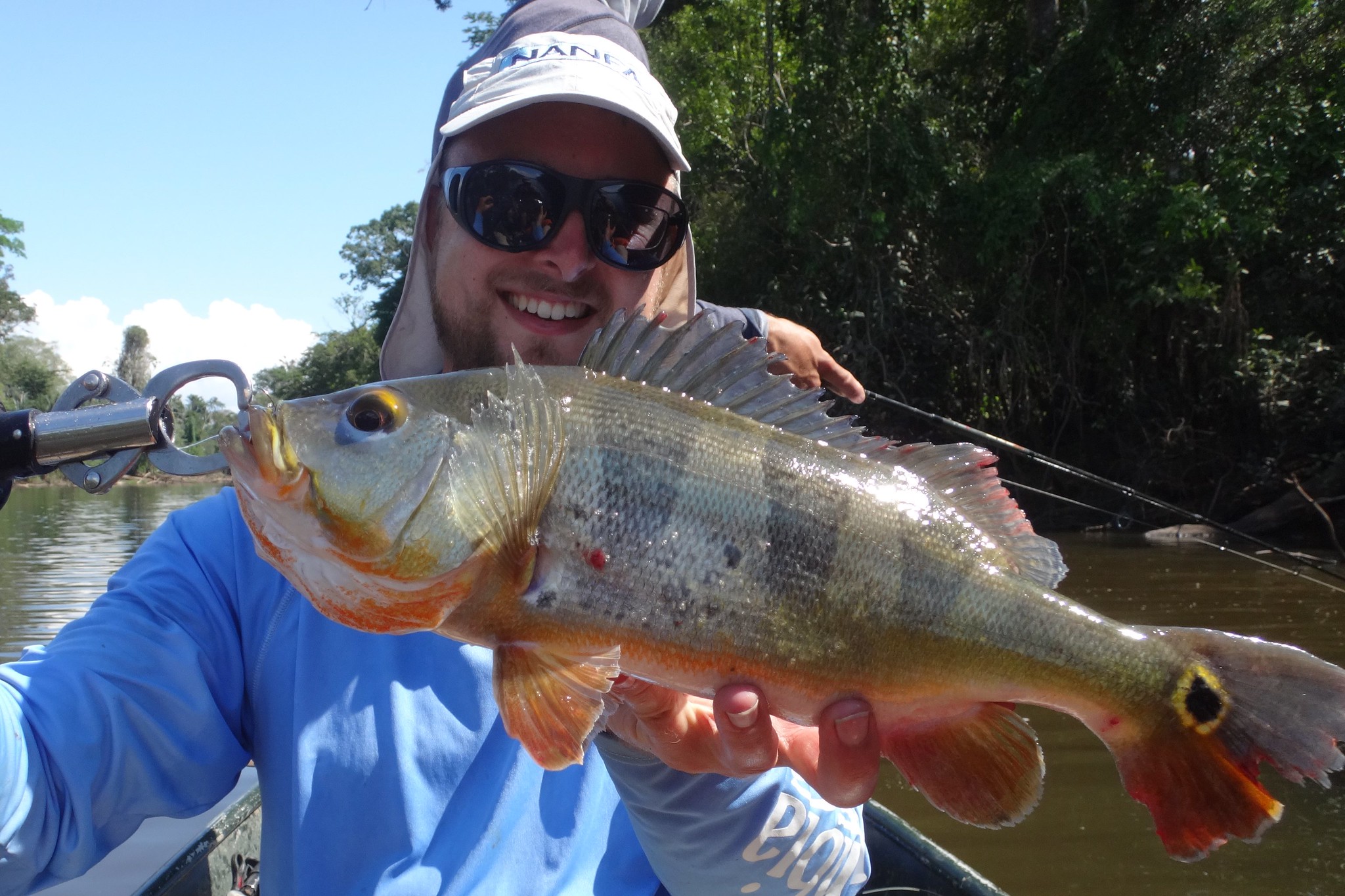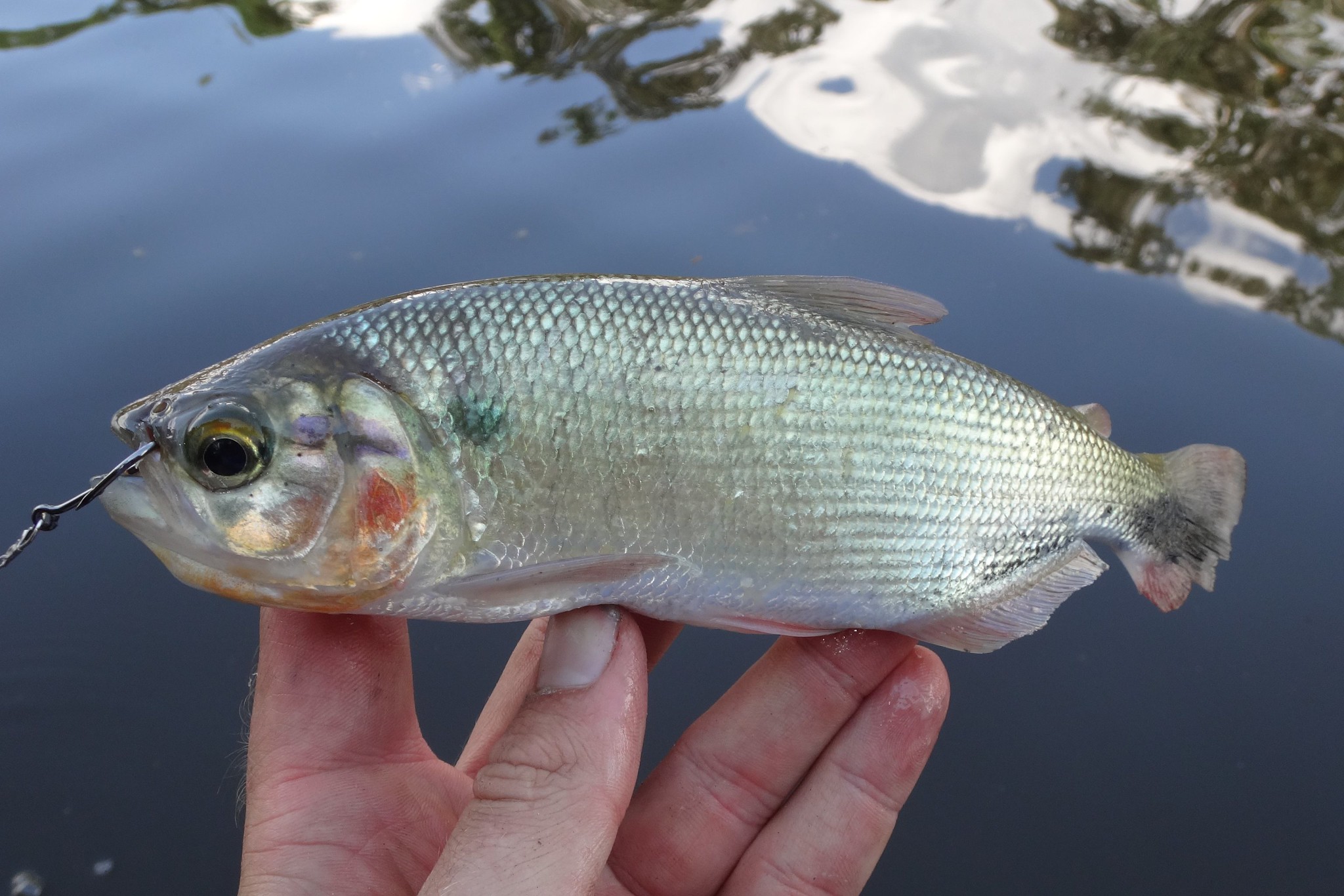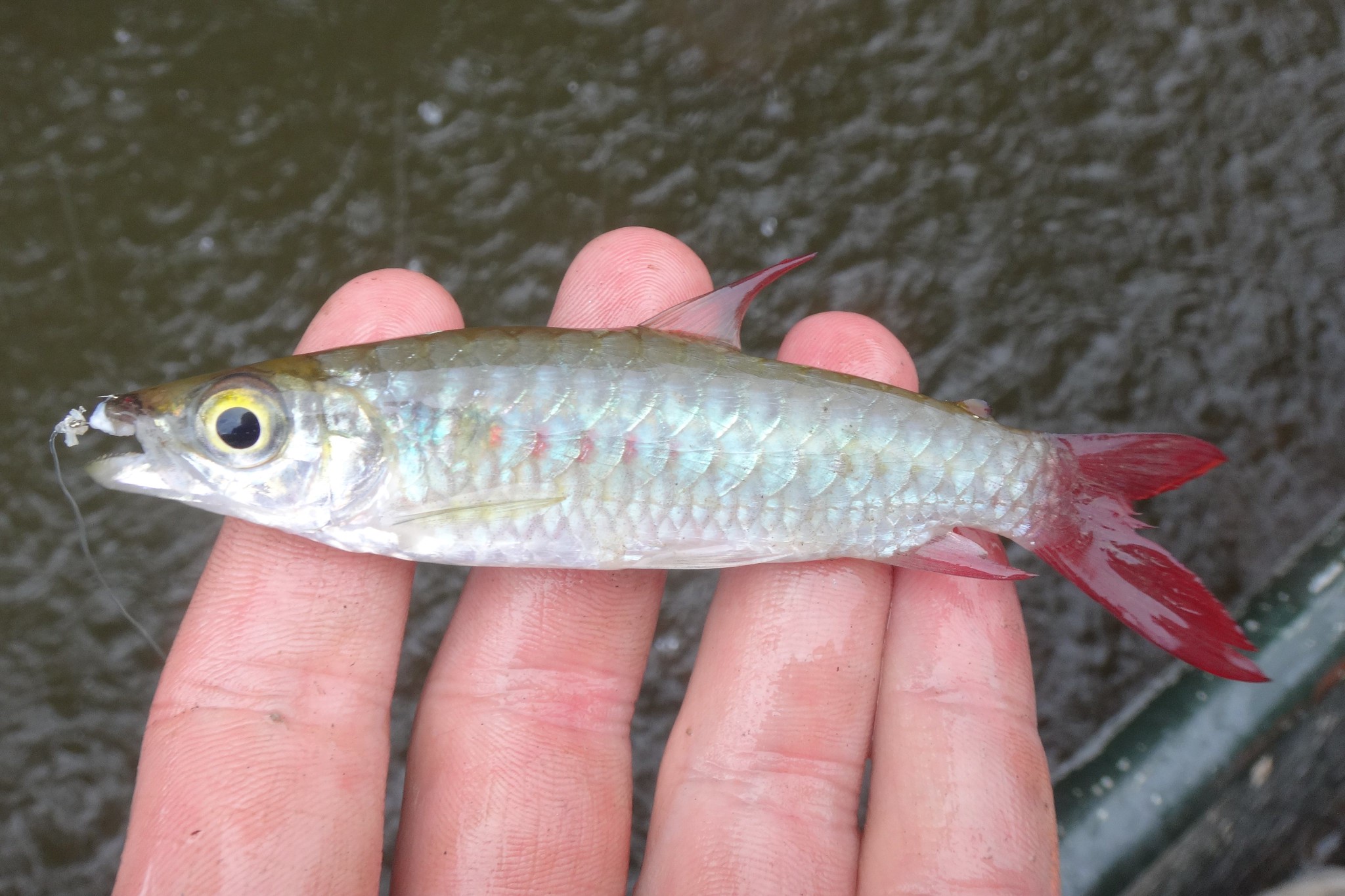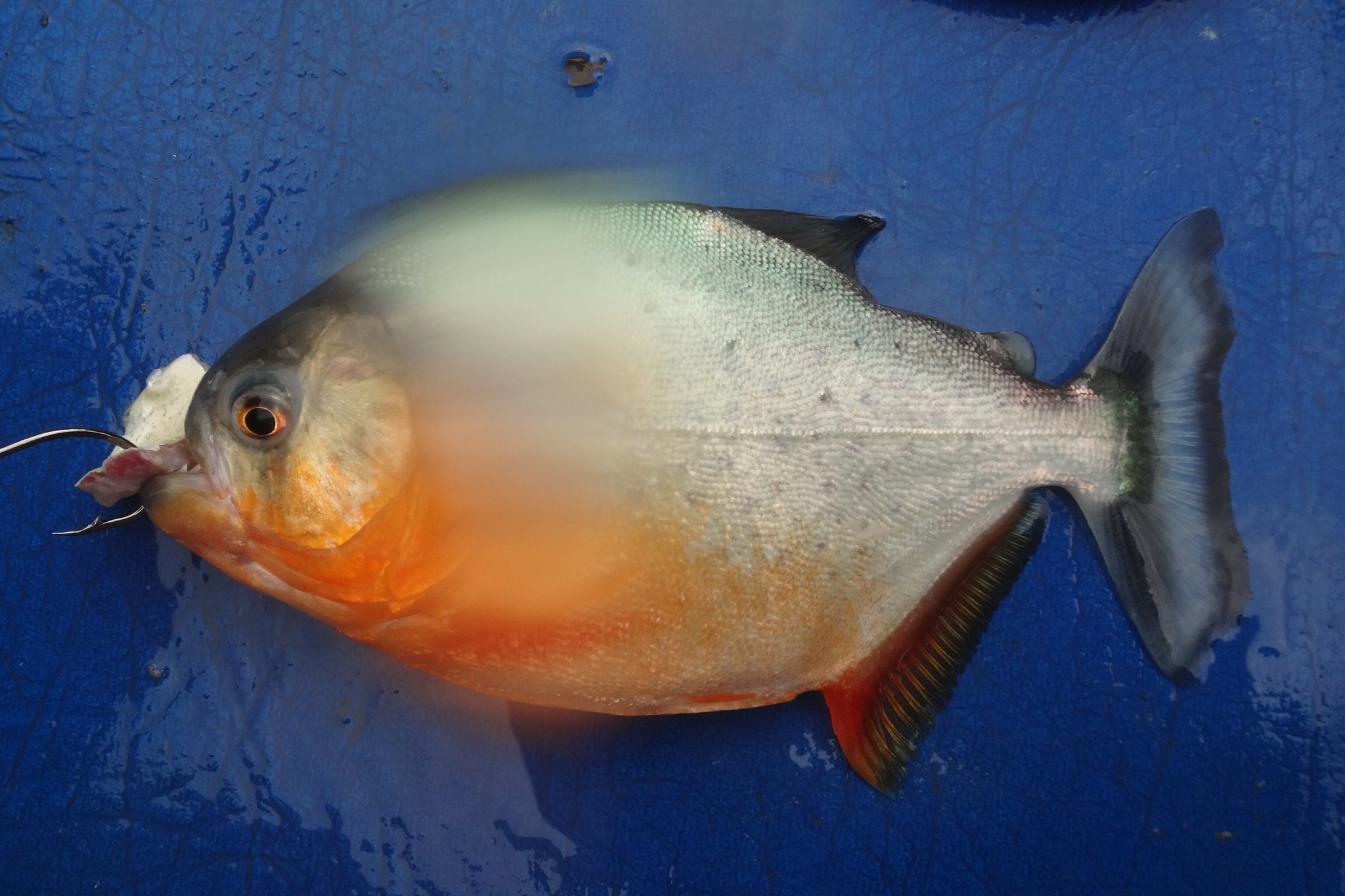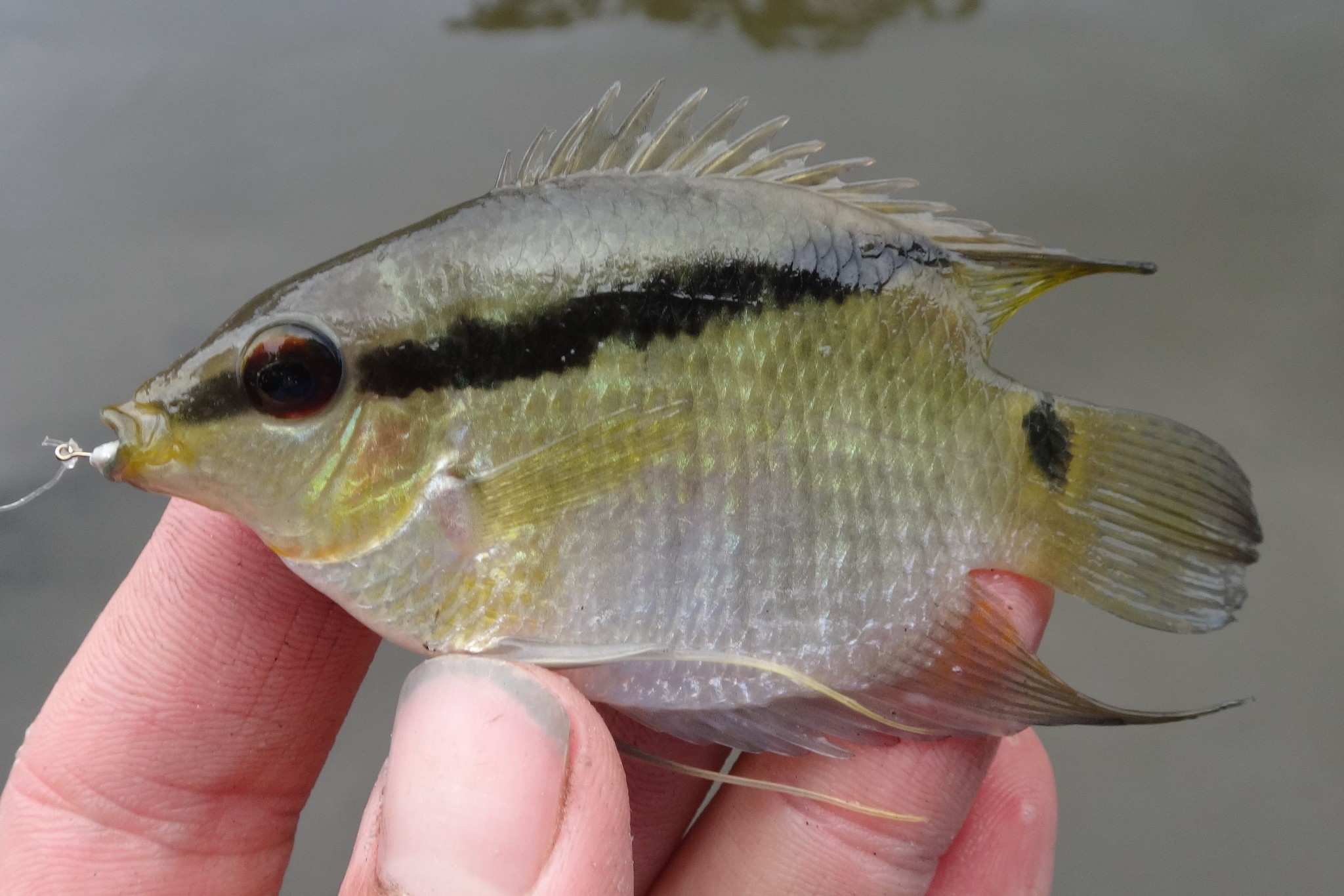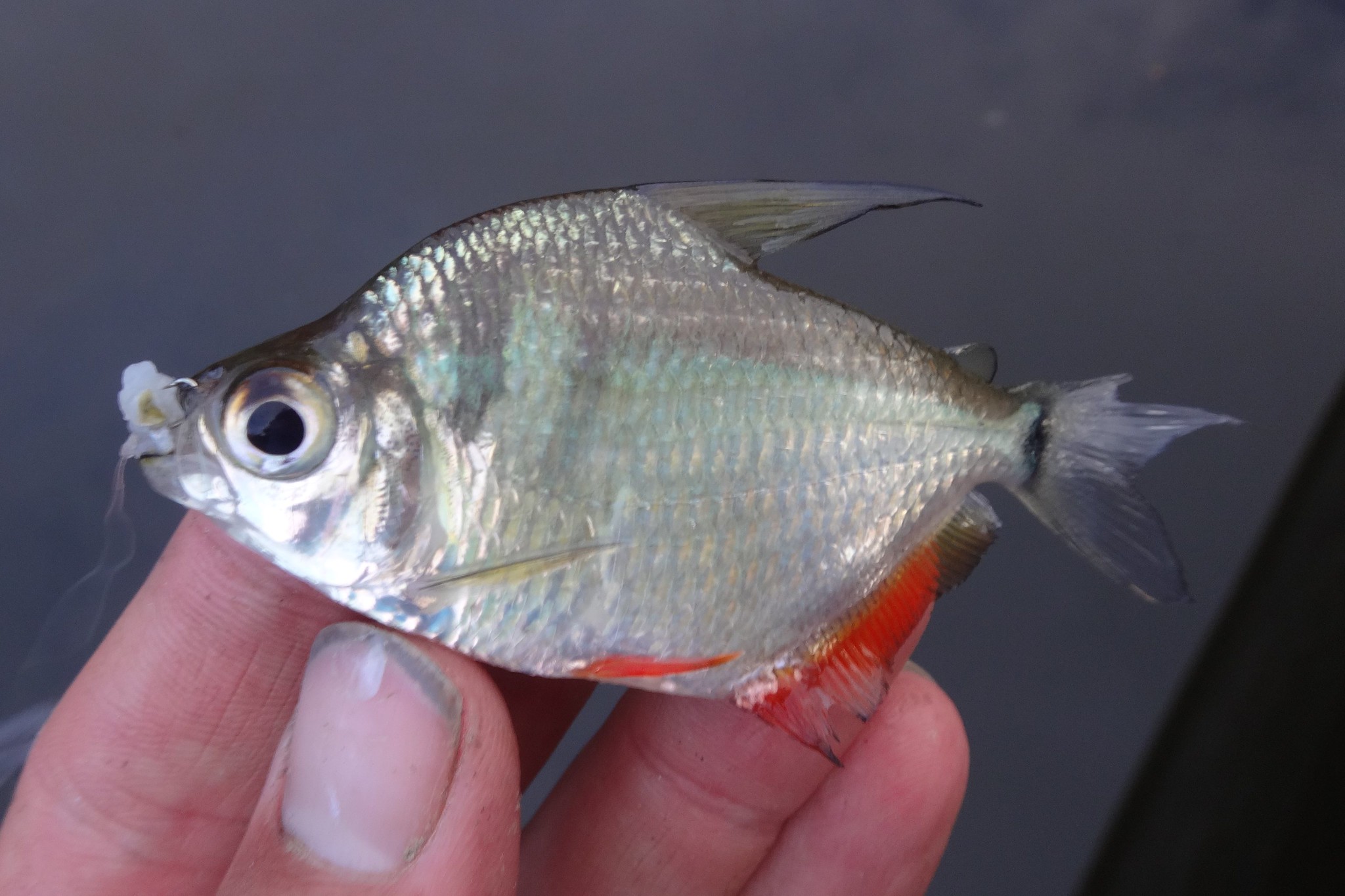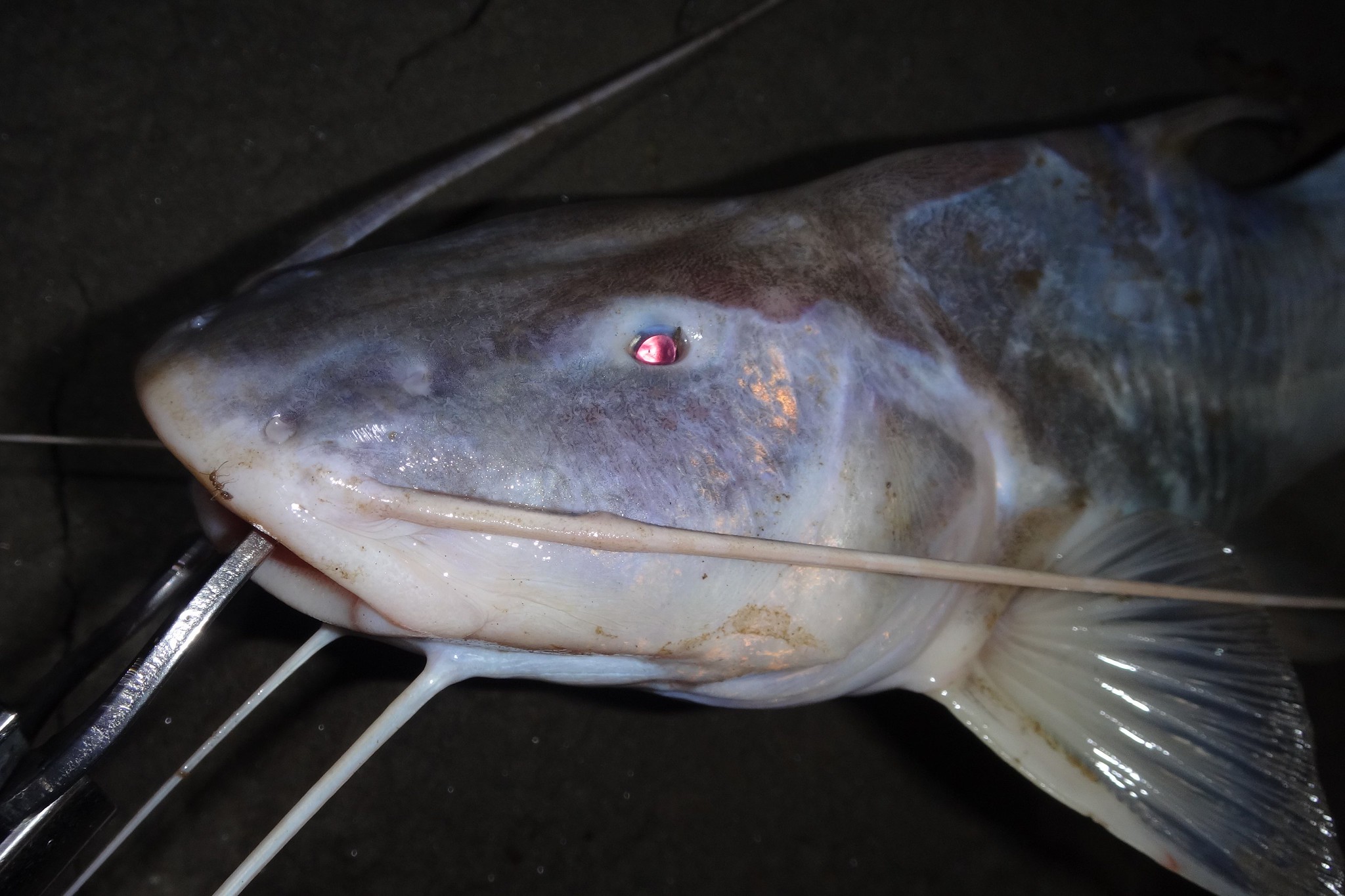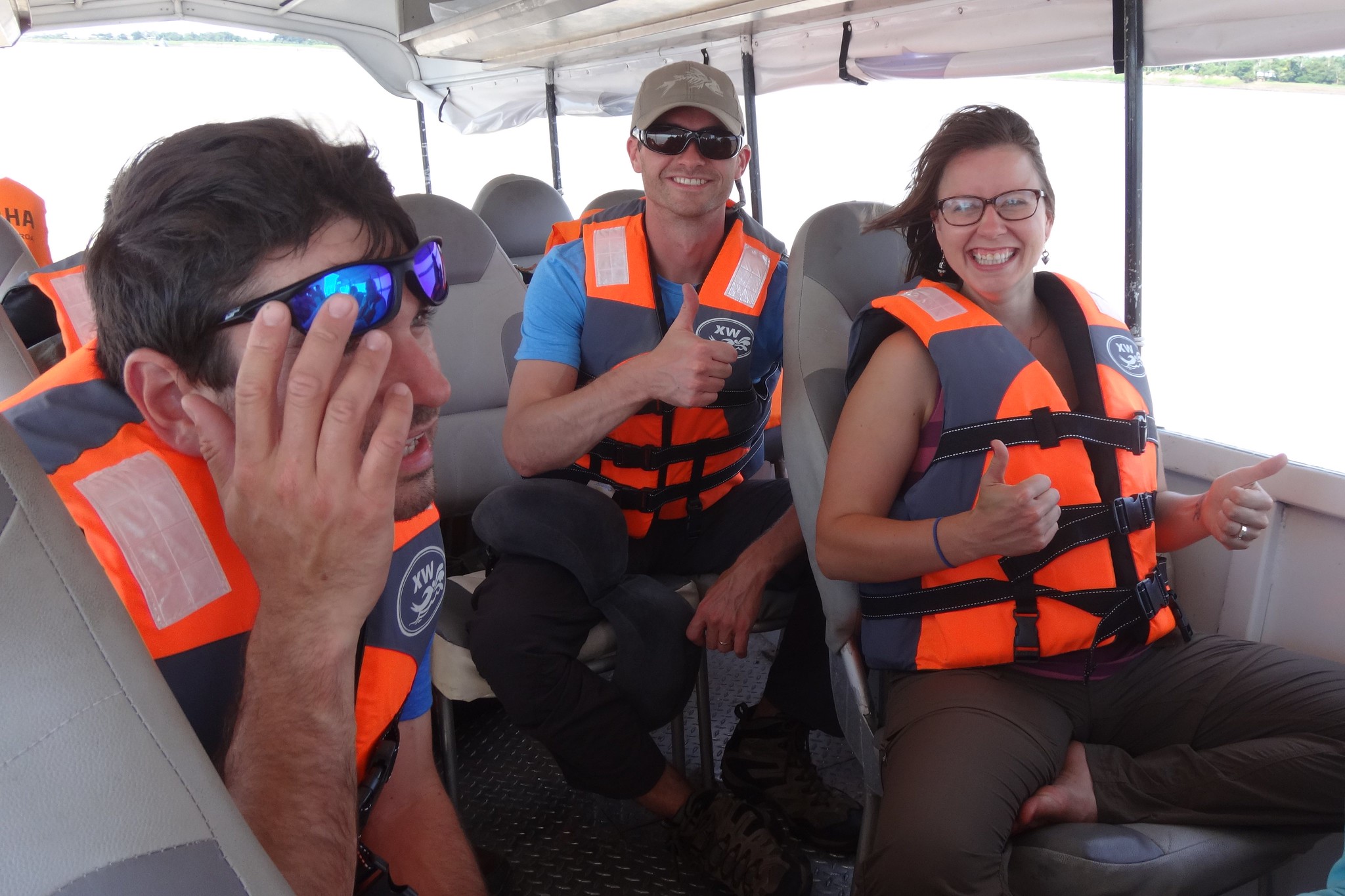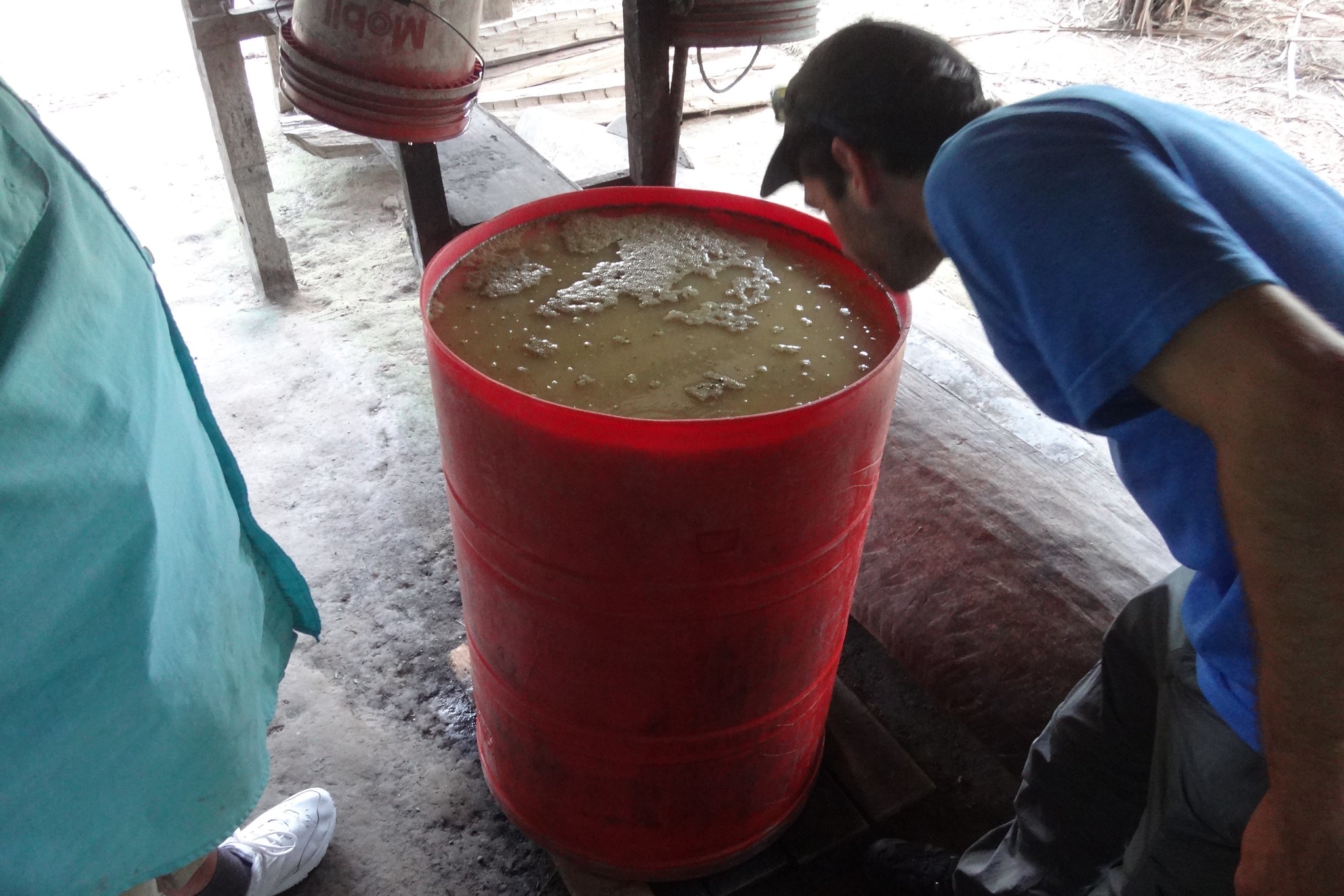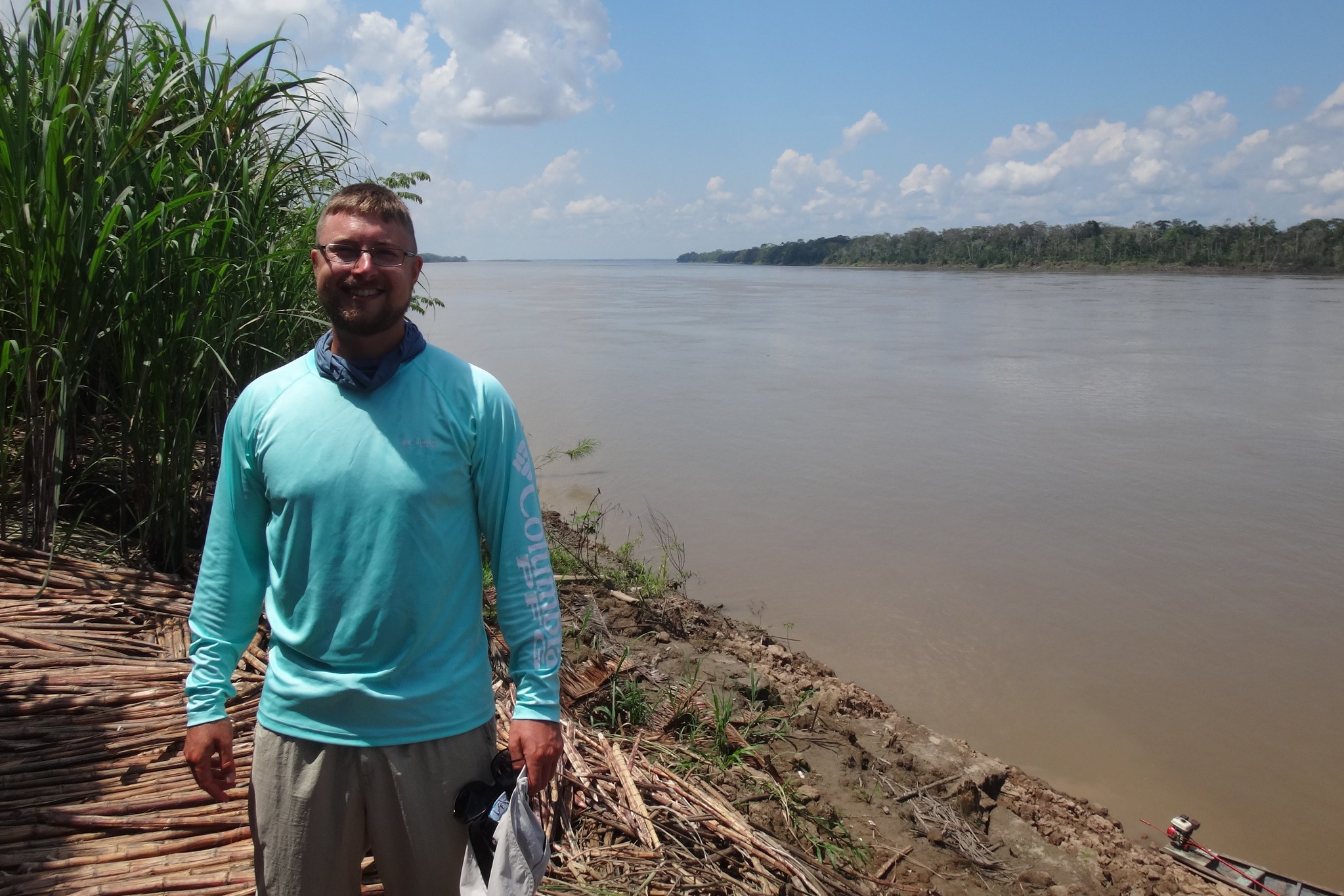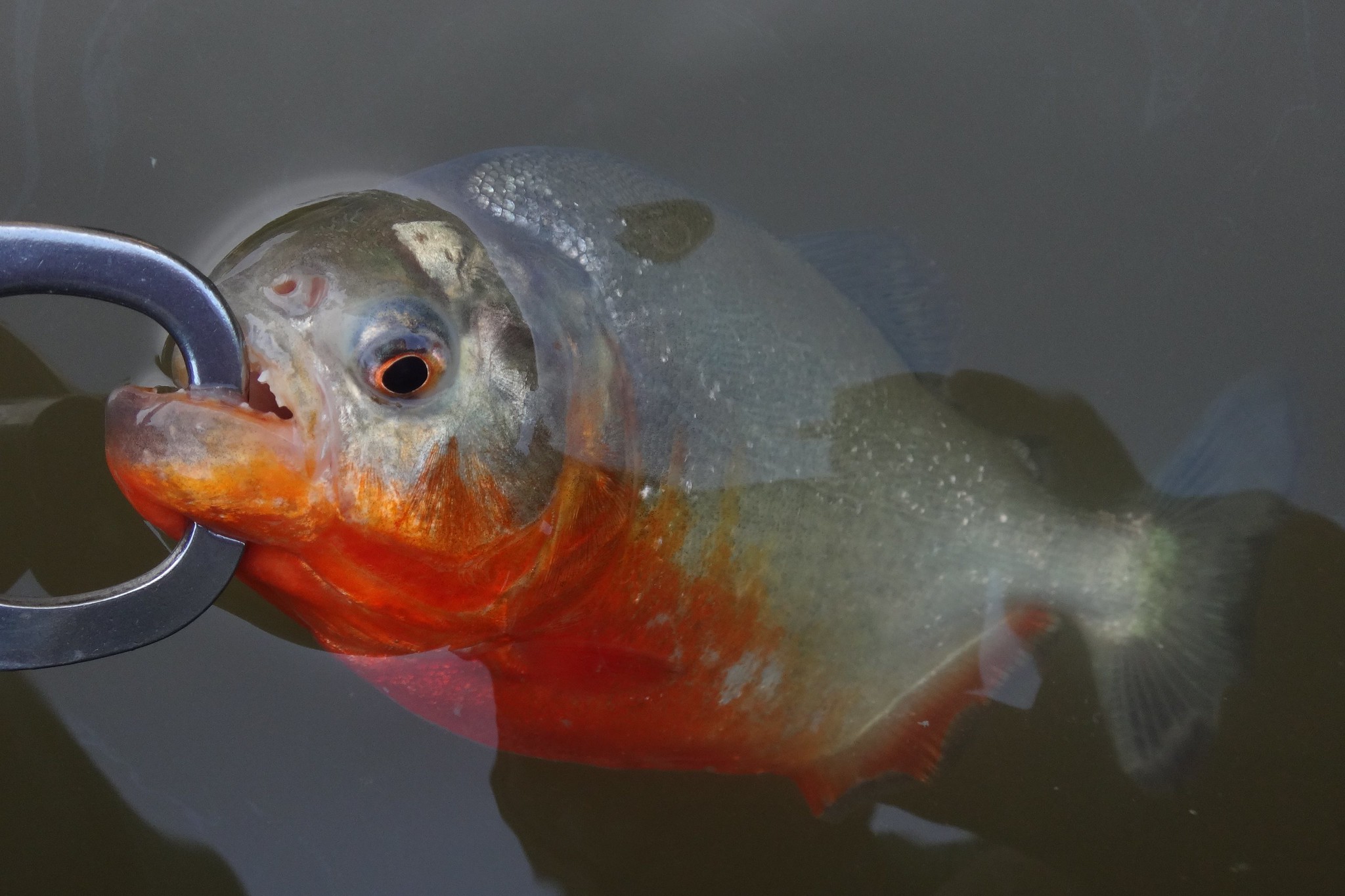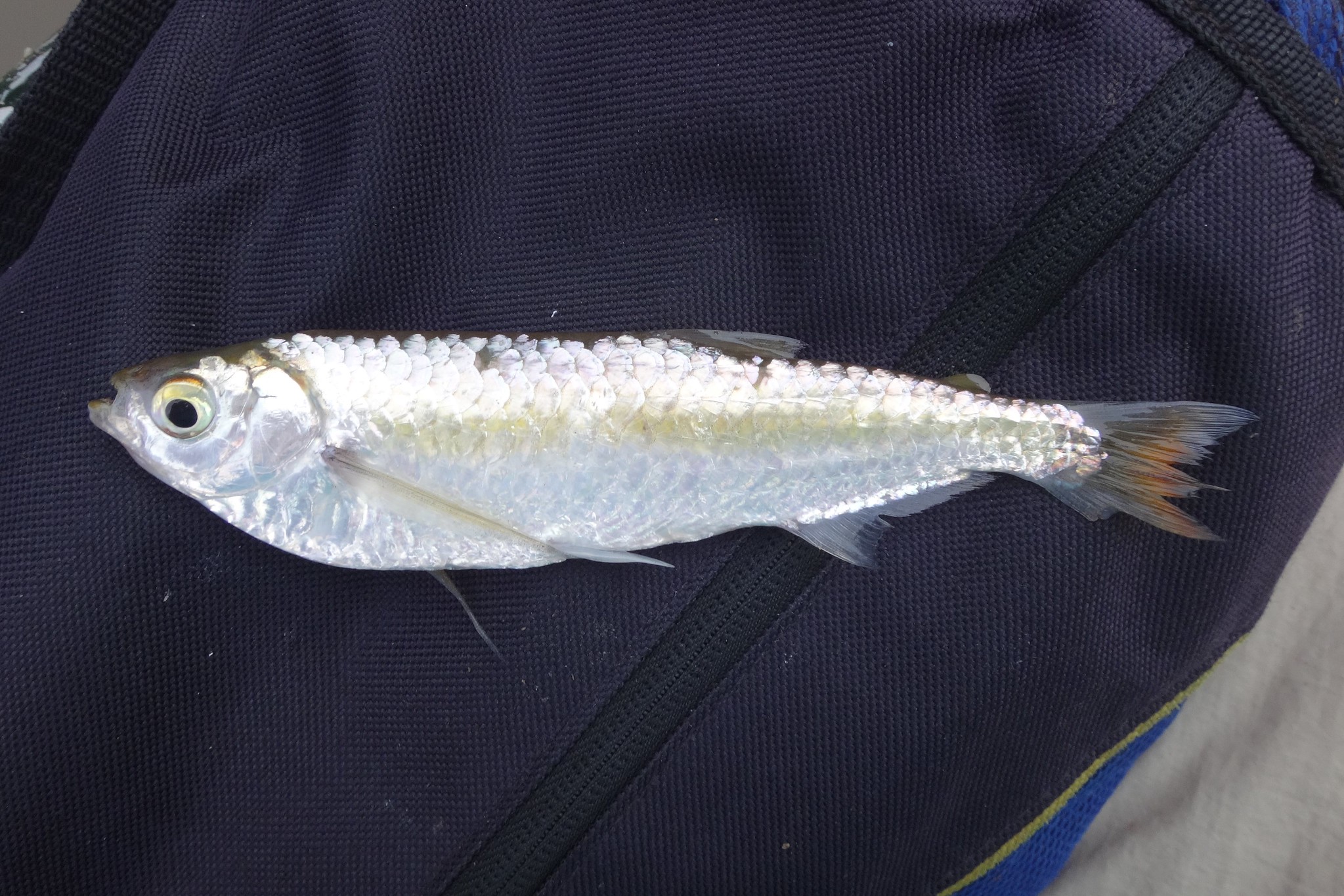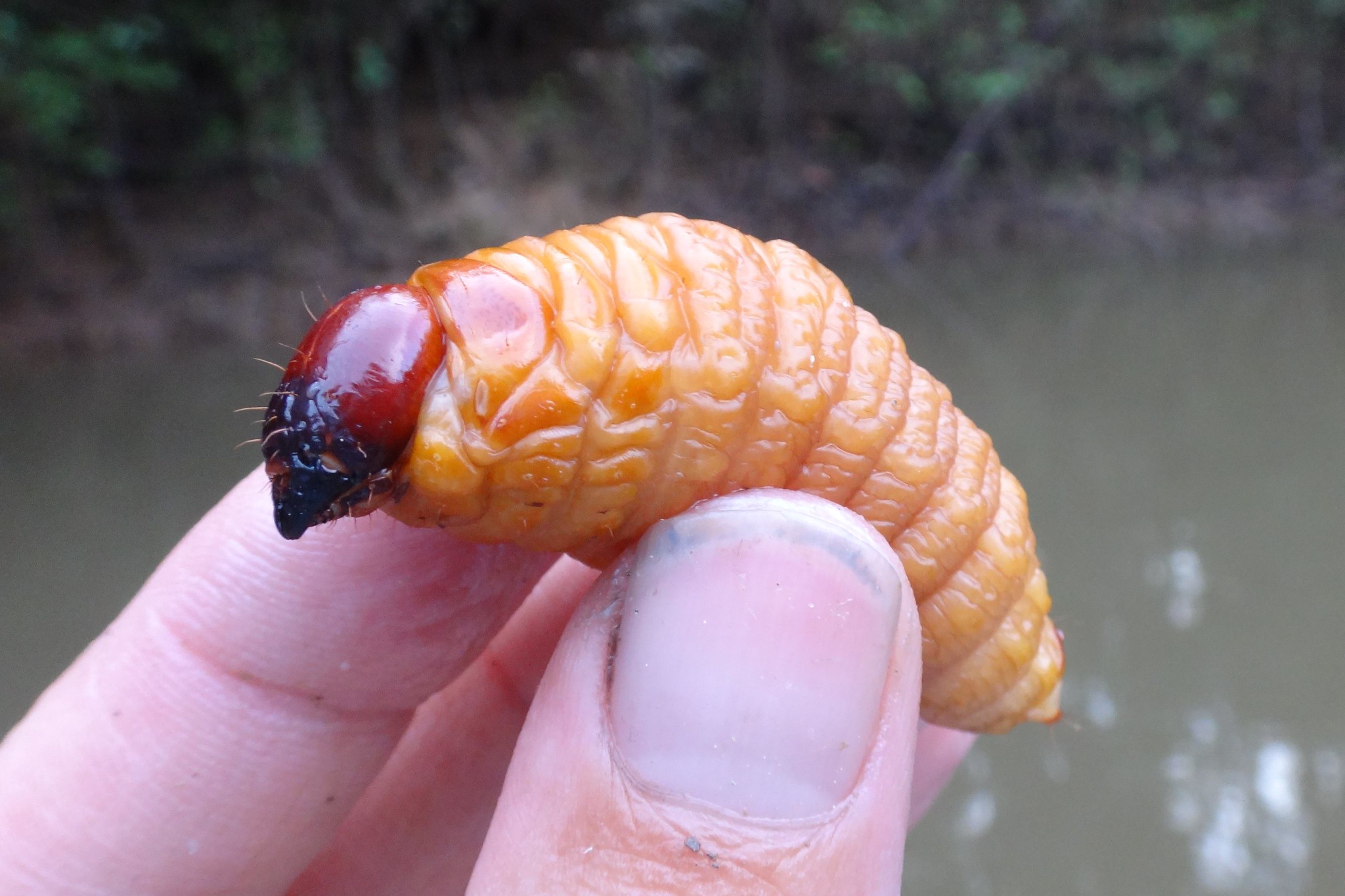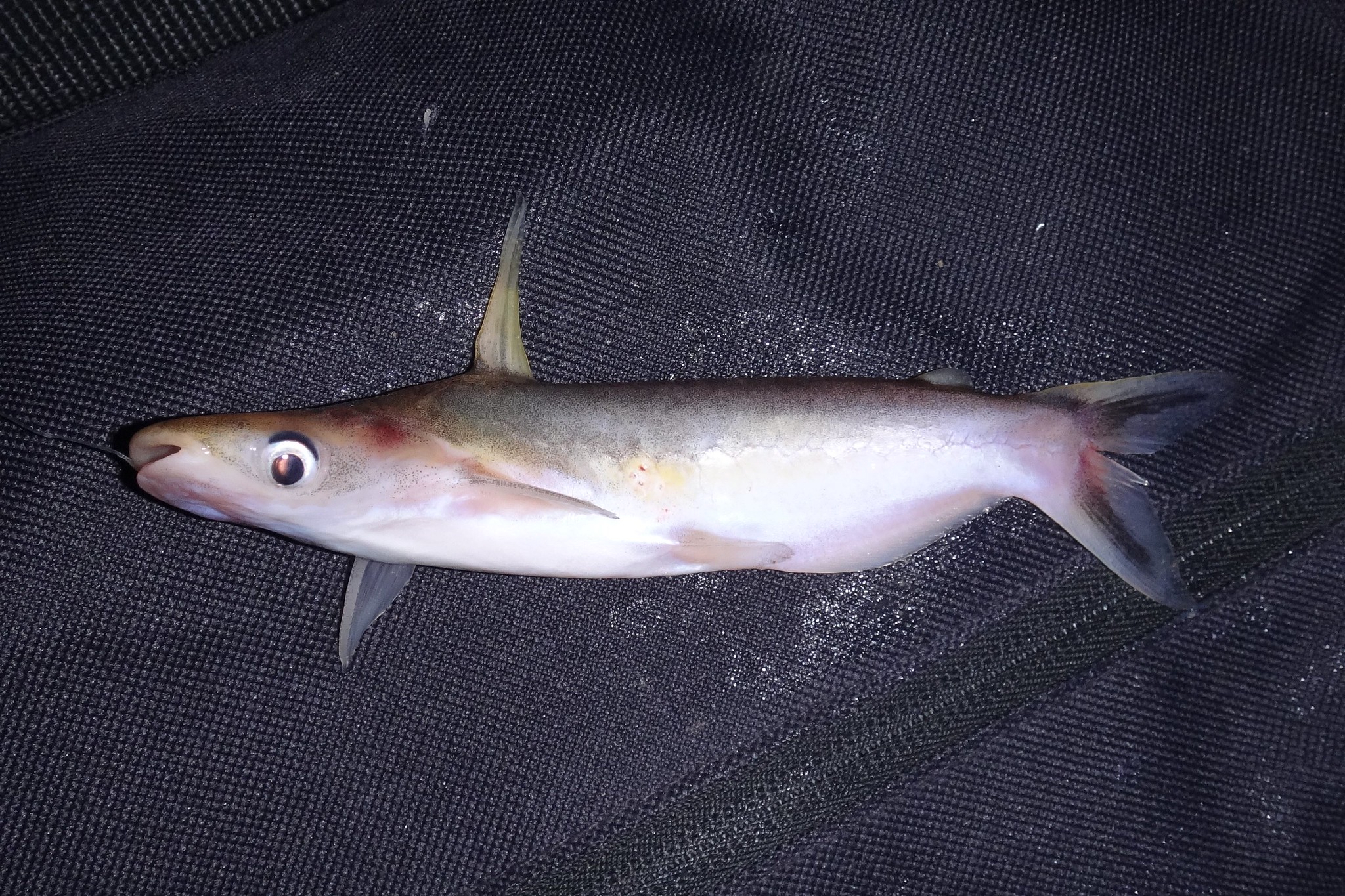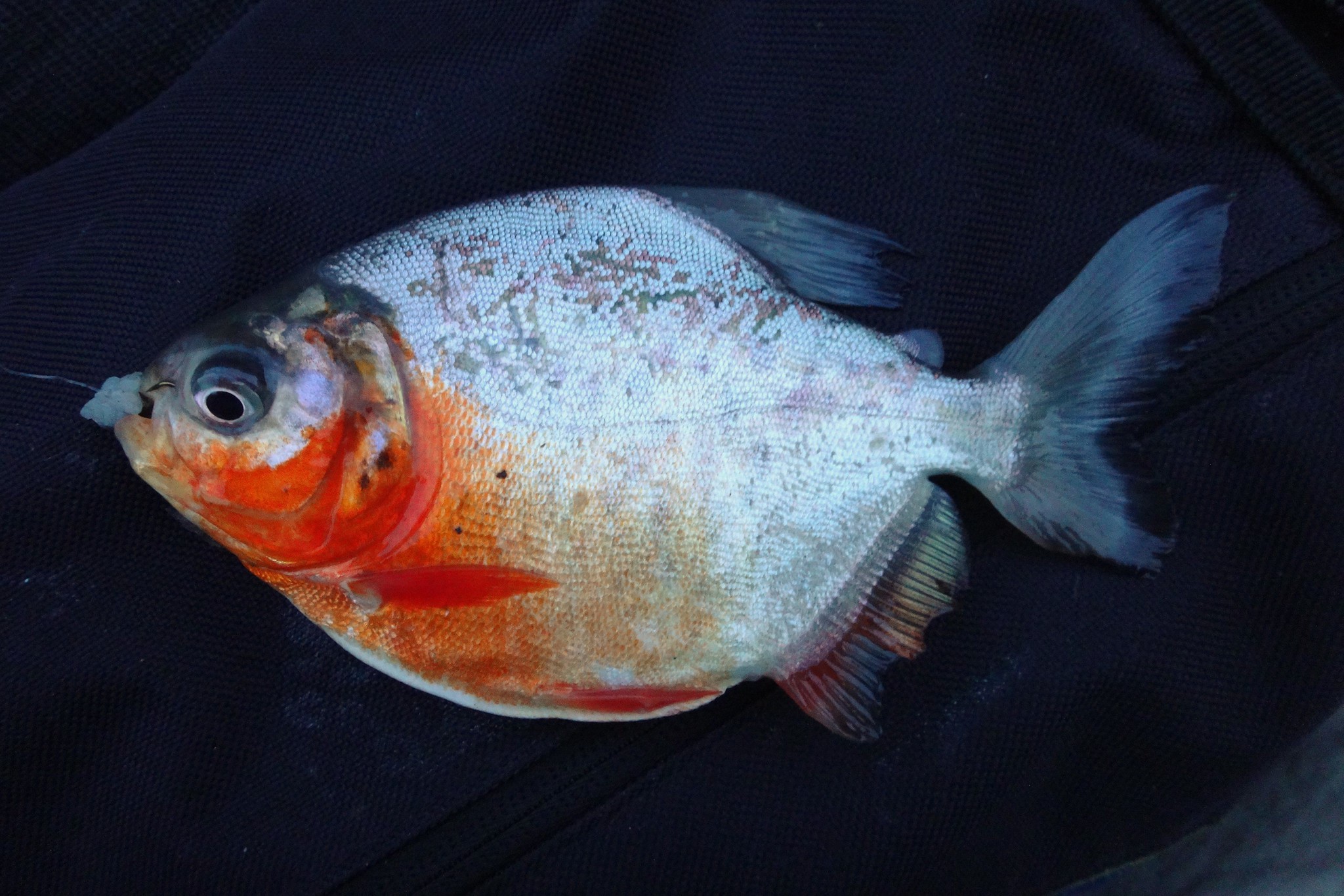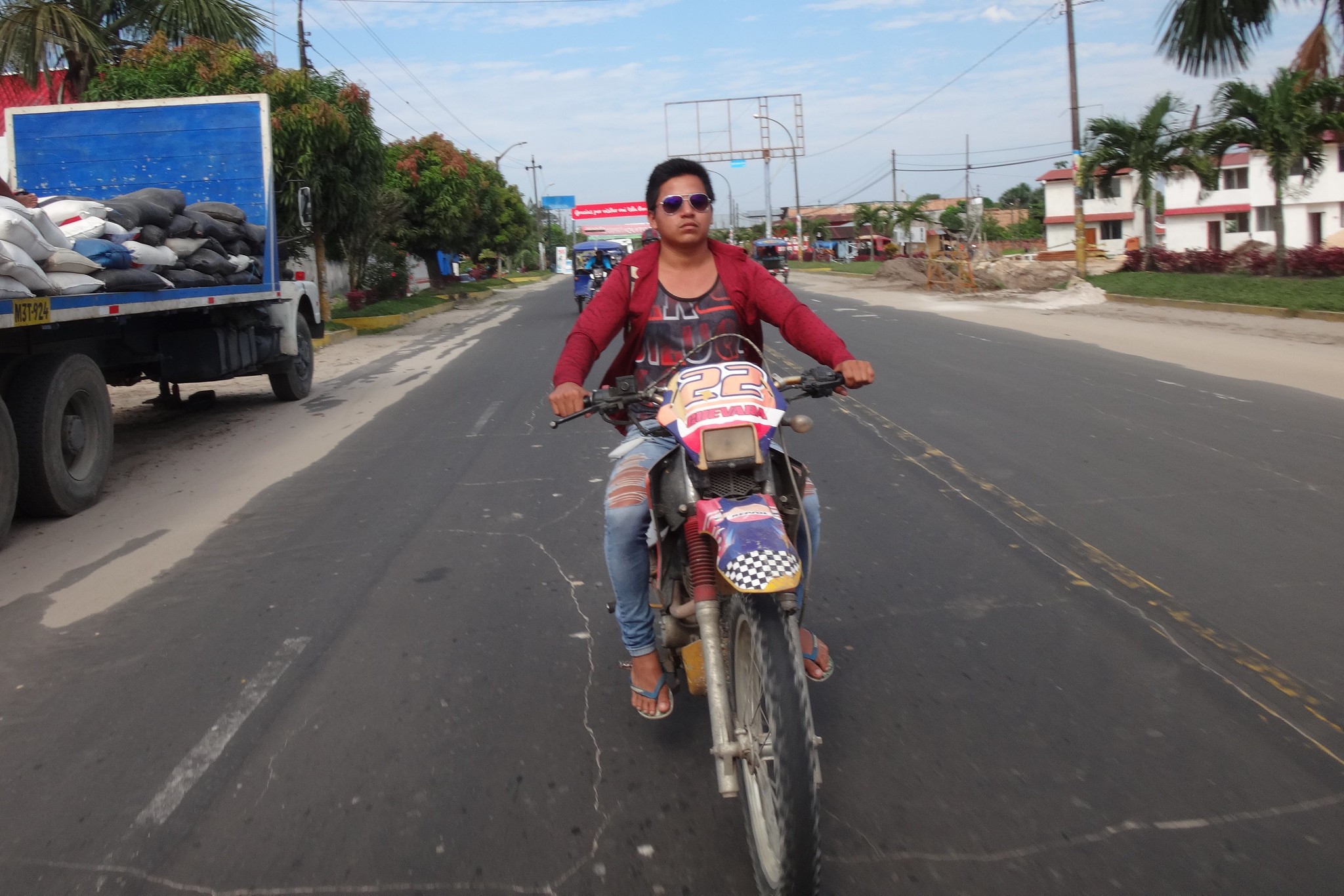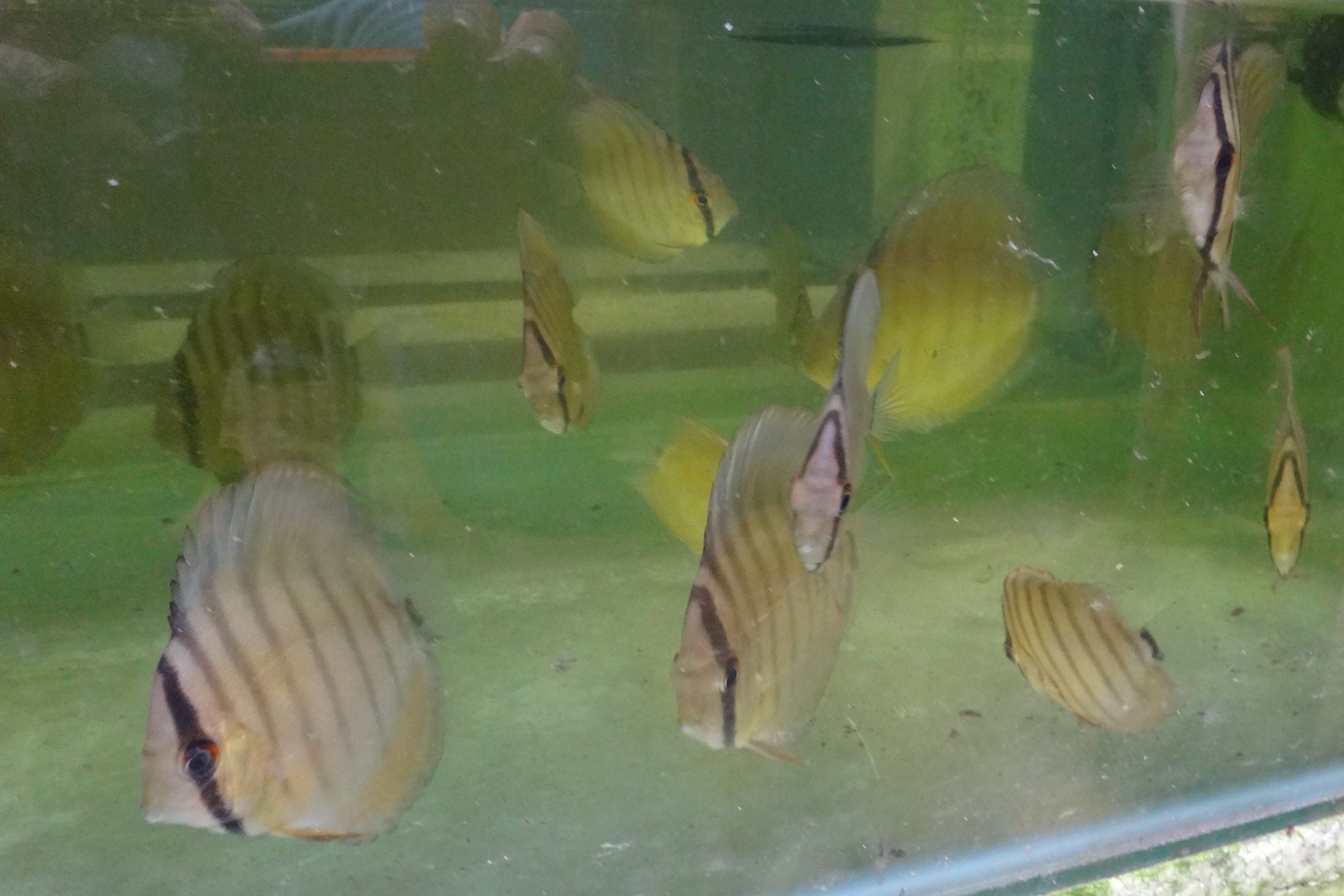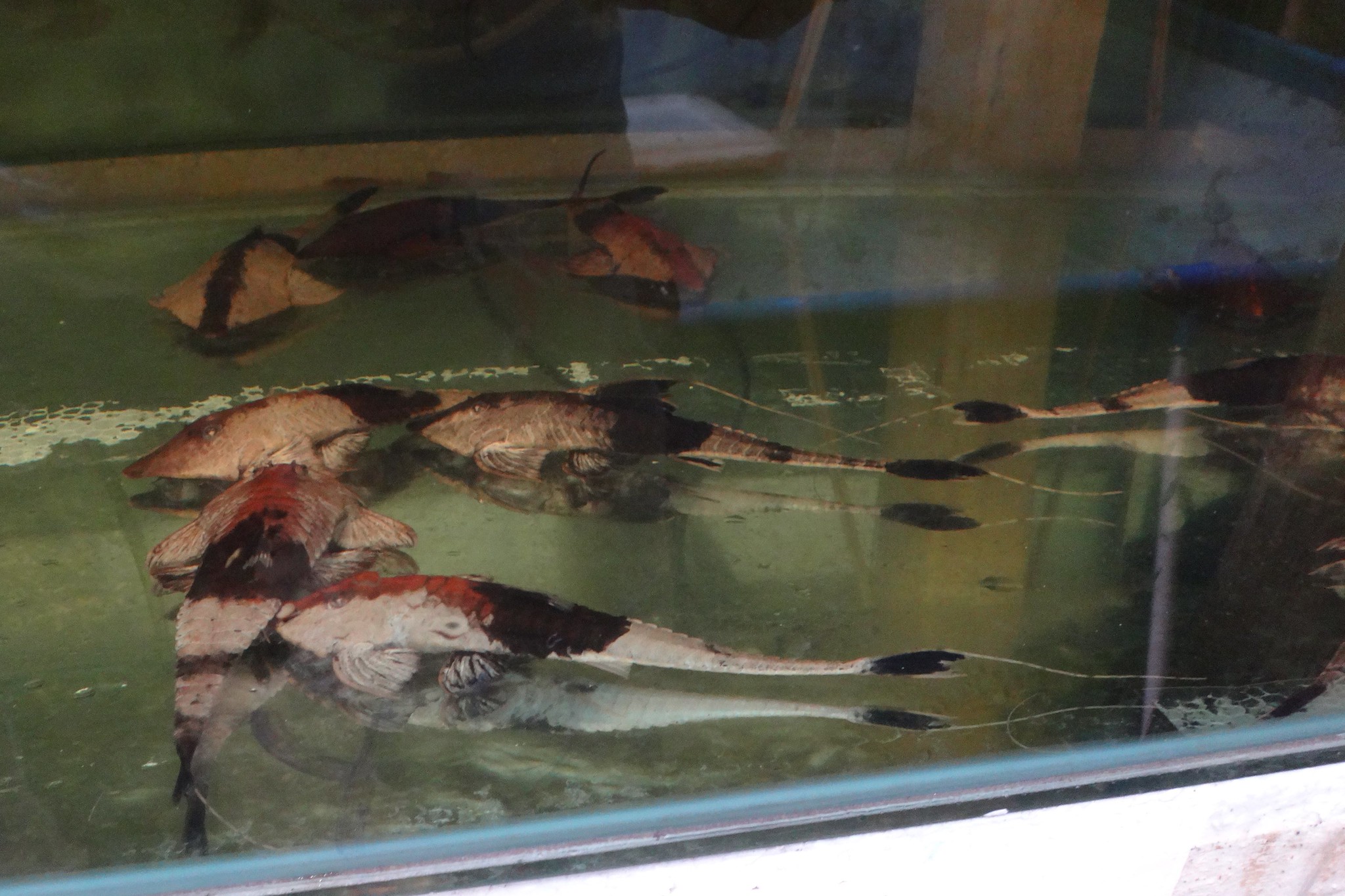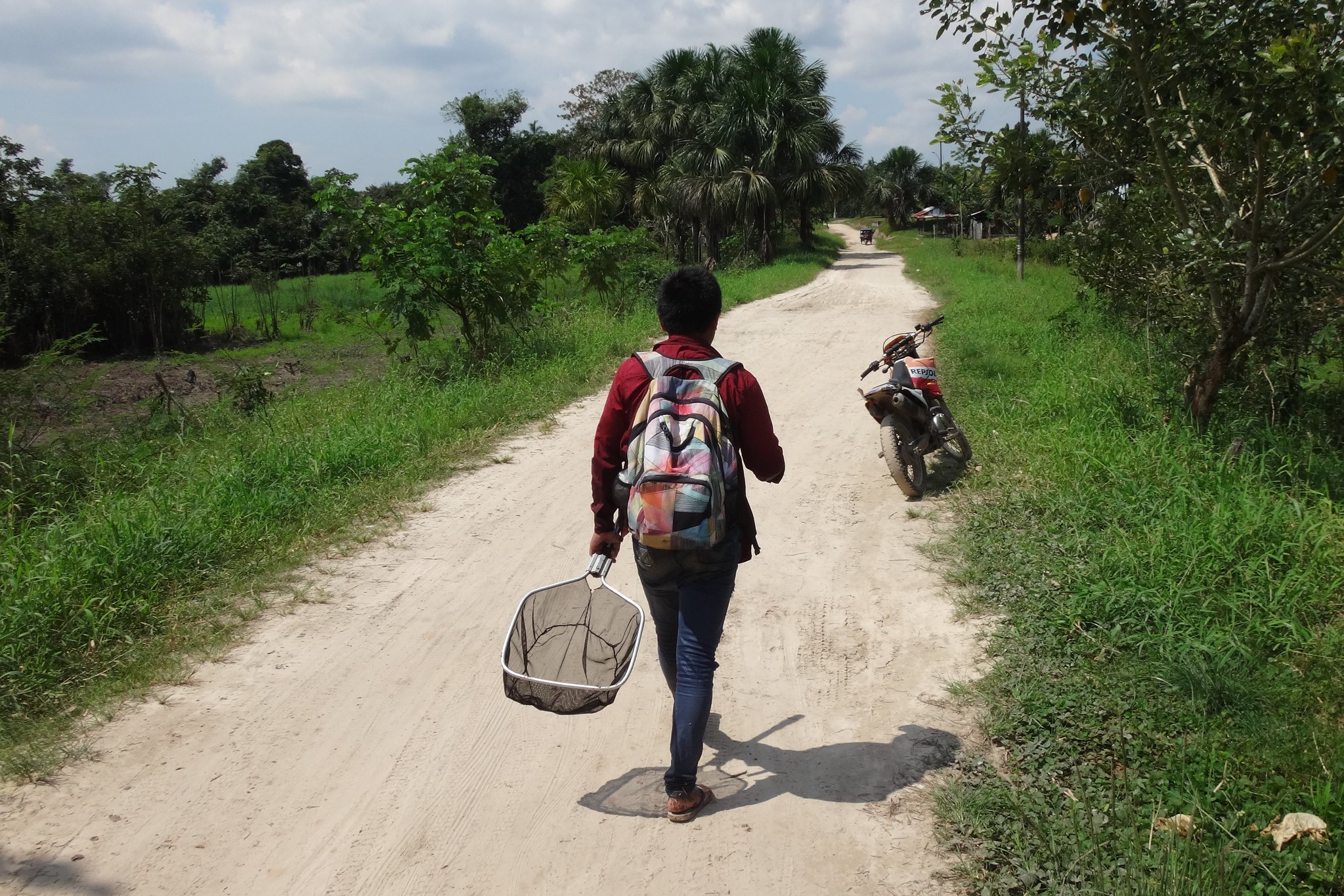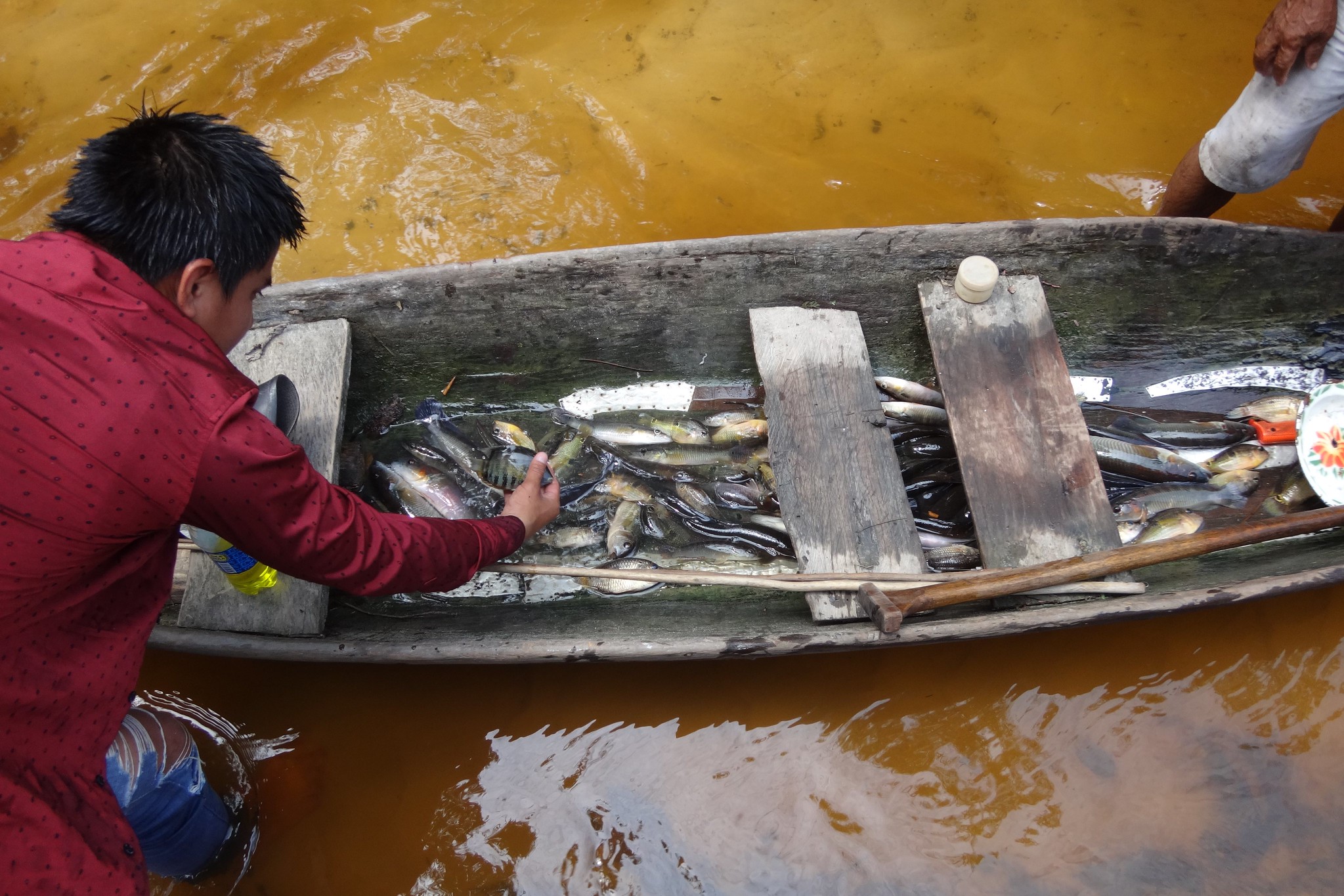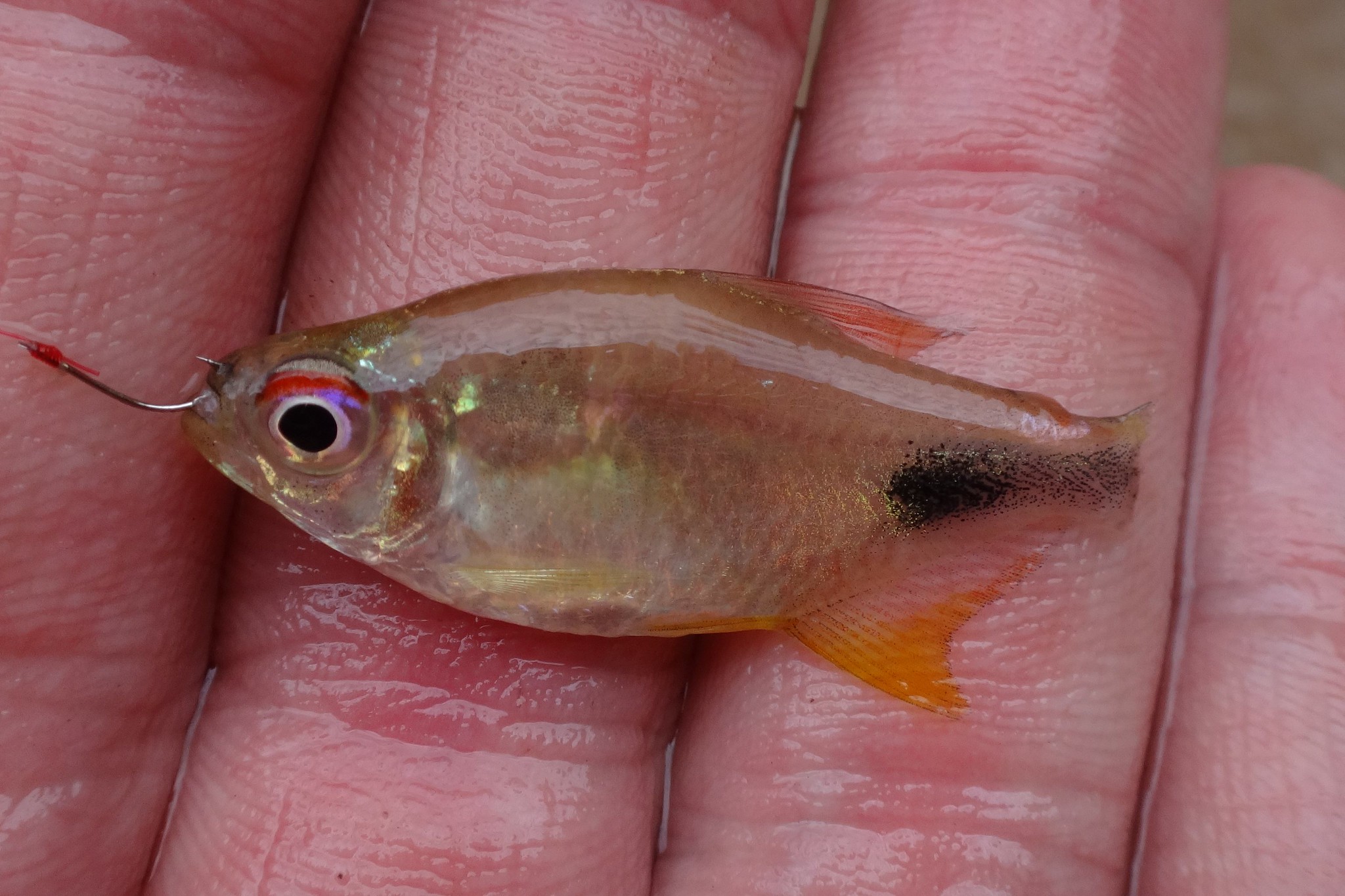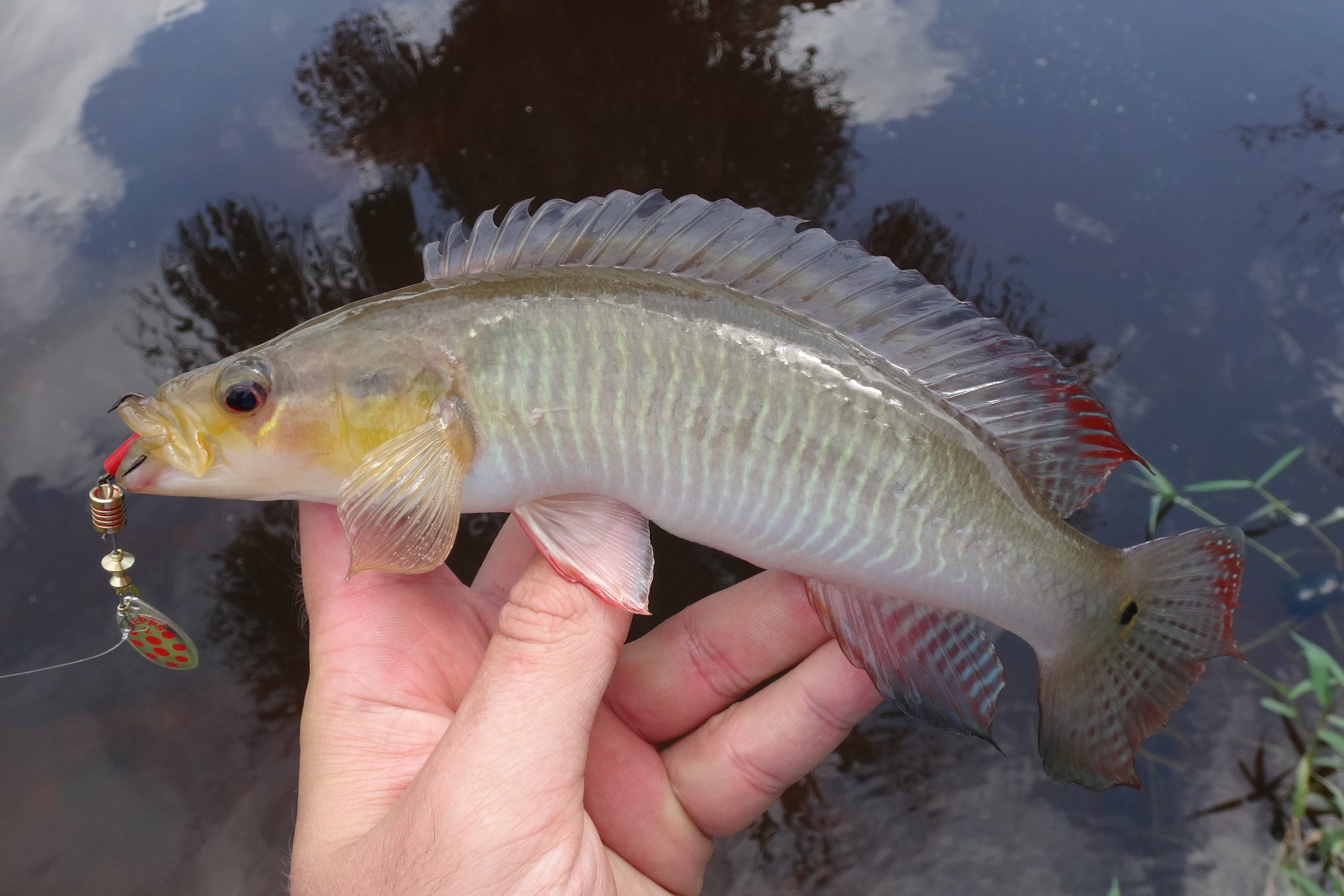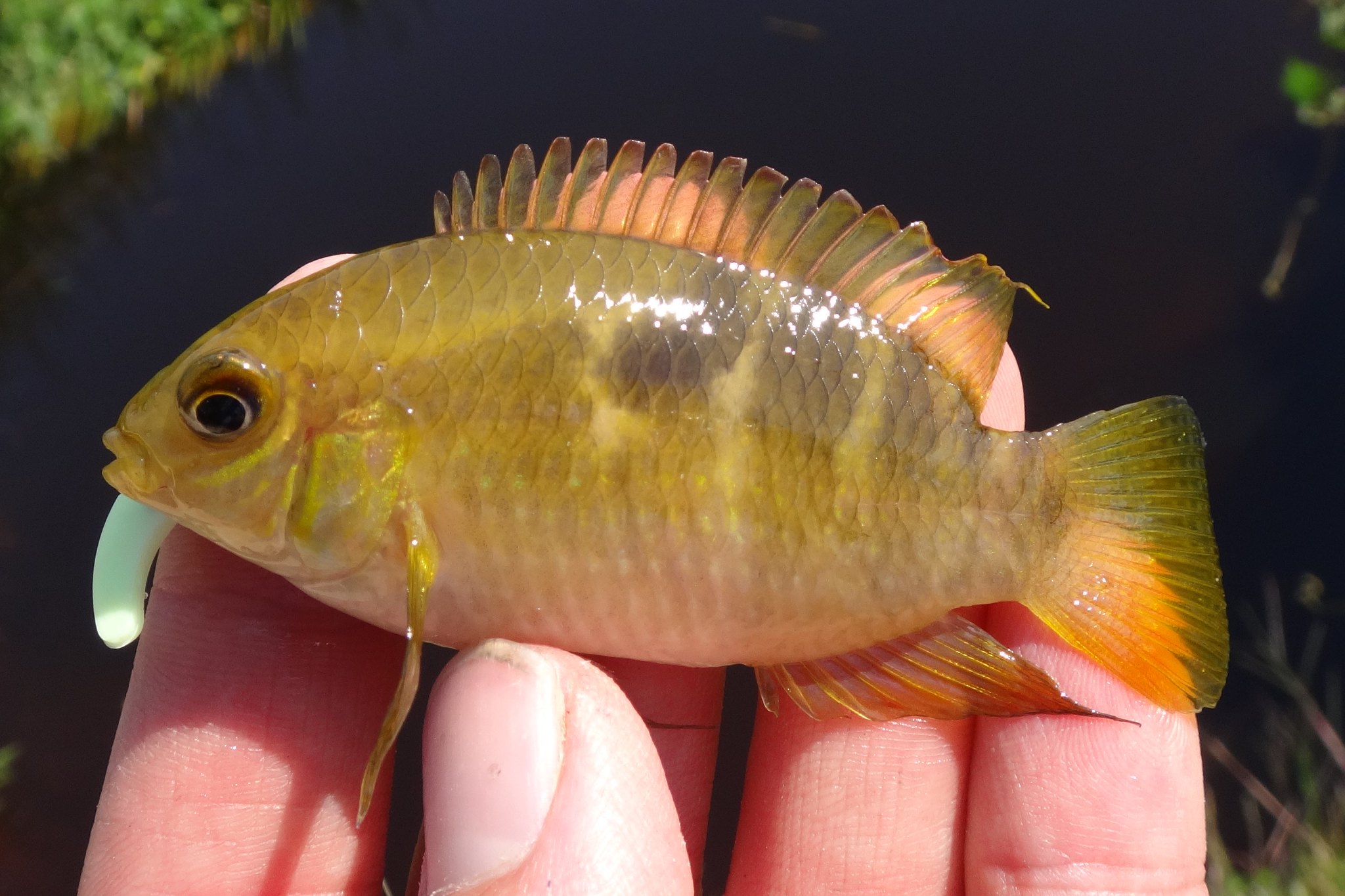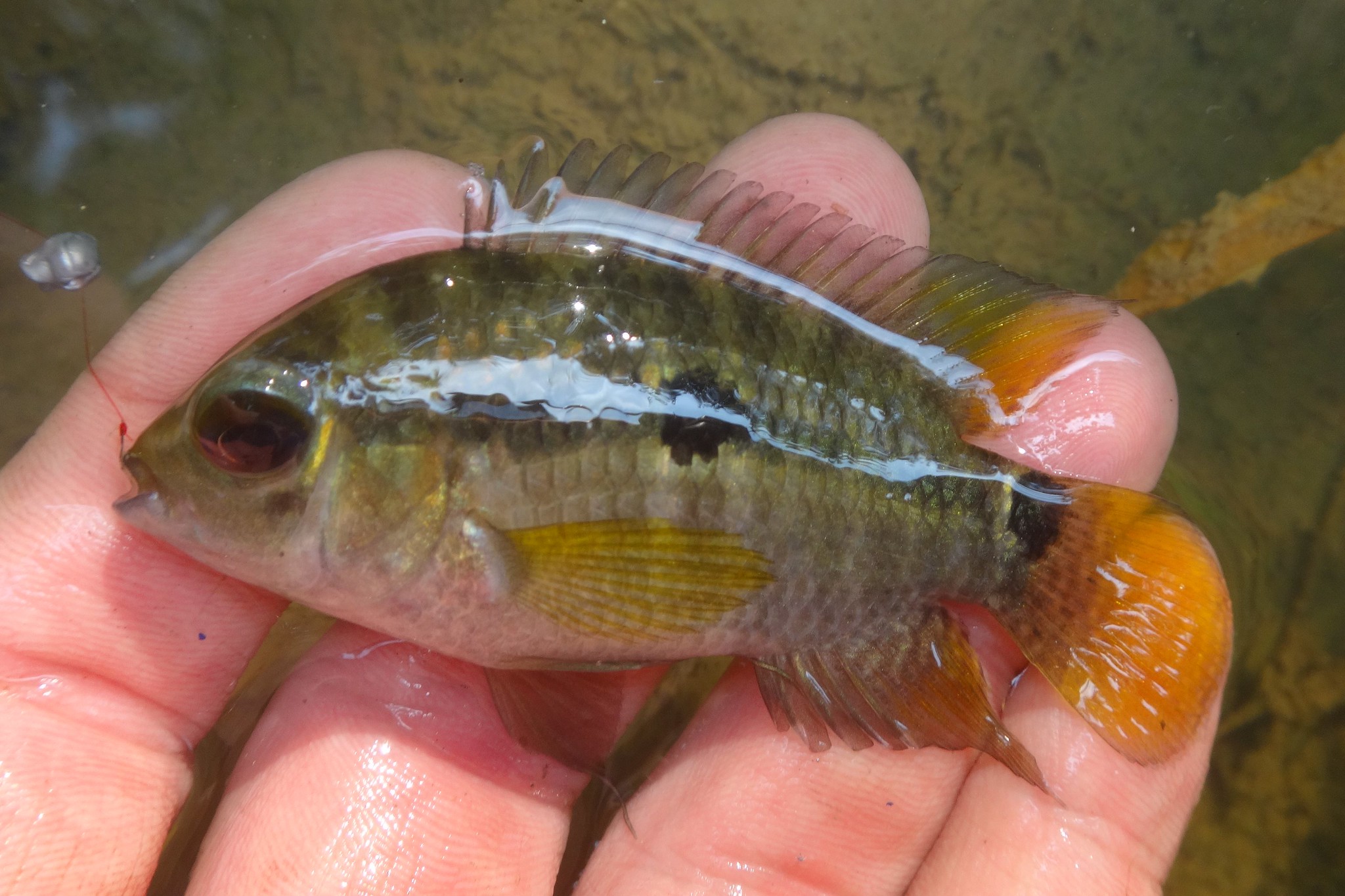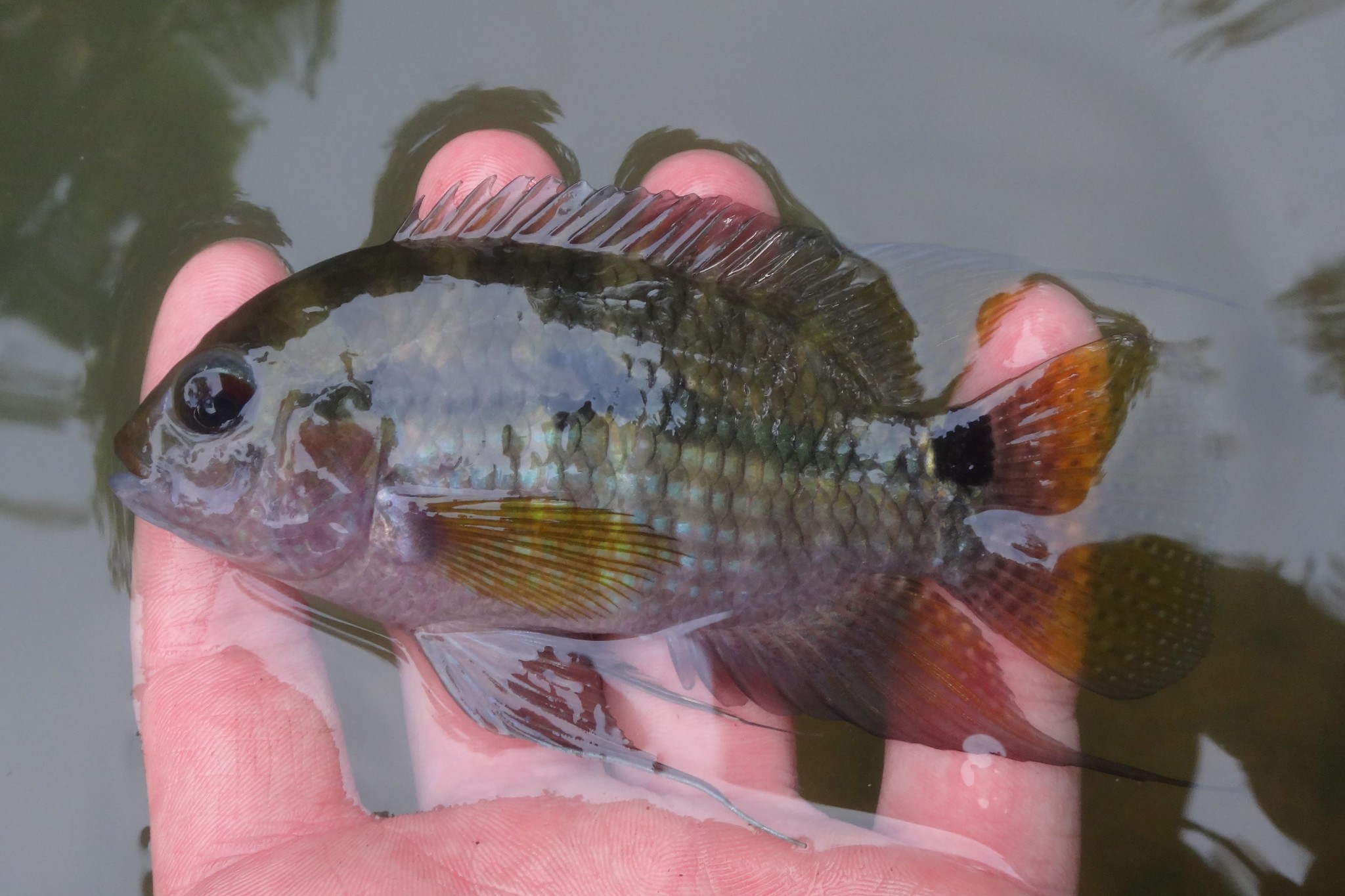We woke up early on day 3 with plans to visit a secret peacock bass lake. The lake was quite a few miles up the river, so it made sense to camp a few nights to give us plenty of time to fish. It was still dark when the guides packed the boat with our camping gear (mosquito nets and sleeping pads), and we put together backpacks with what we would need for several days in the jungle. With the promise of a big thermos of coffee on the boat, we loaded our gear and followed the creek out into the mainstem Amazon.
The boat we took wasn't fast like Otorongo's yellow speed boat, so we had plenty of time to kill. Rojelio, one of the local guides, worked on the mosquito nets to make sure they were ready for the evening.
We certainly had plenty of gear. Michael and George were frequently asleep whenever we traveled in the big boat. They were the only two who didn't drink coffee, which probably explains how they could doze off so easily.
We motored up one of the Amazon's tributaries and tied off near the mouth of a small creek. At this point we switched to the canoes that we had towed behind the big boat. The creek was packed with fallen wood, and the going was tough. We often had to hop out of the canoe so it could be pushed over a submerged log.
There was a large fallen tree blocking the entrance to the lake, so we had to wait in line as we went over one at a time. While we waited I dropped a piece of bait over the side and caught my first fish of the day!
Trahira (Hoplias malabaricus) - new hook & line species #361
Check out those teeth! We didn't catch any larger specimens, and honestly I'm not sure how much larger this particular species can get. They're a close relative of the more famous wolf fish, which can definitely get much larger.
Finally, we made our way into the lake, and we were excited to finally cast our lures. I tied on a chartreuse and orange rattletrap, threw it close to shore, and it got hit right away! The peacock bass lake lived up to its name.
Monoculus Peacock Bass (Cichla monoculus) - new hook & line species #362
My next fish was a pike cichlid similar to the one I caught in Iquitos, but it was a different species. The purple color on its belly really stood out.
Johanna Pike Cichlid (Crenicichla johanna) - new hook & line species #363
Peacock bass continued to hit our lures. You'll notice most of the fish from this lake had their tails chewed up pretty badly - likely from piranhas or other fish with teeth.
Monoculus Peacock Bass (Cichla monoculus)
Casting lures close to structure near shore continued to produce the same two species. Notice the creepy shirtless guy in the lower left below. That's Anthony, the lodge owner!
Trahira (Hoplias malabaricus)
I took a photo of every peacock bass I caught, hoping there would be more than one species. However, we concluded that we only caught C. monoculus. This one had some pretty nice orange coloration on its underside.
Monoculus Peacock Bass (Cichla monoculus)
Michael was partnered up with me in the canoe. We decided to switch tactics in hopes of catching different species. Cut bait produced this brycon, which is a large species in the characin (tetra) family.
Red-Tailed Brycon (Brycon cephalus) - new hook & line species #364
We noticed a lot of small fish with red tails swimming near the surface. They would attack our cut baits, but we knew we needed to switch to micro gear to hook them. We put them off for a while, but eventually I downsized my hook so I could catch one.
Red-Tailed Tucan Fish (Chalceus erythrurus) - new hook & line species #365
Michael was struggling to set the hook with the tucan fish (they had really bony mouths), so I told him to watch what I was doing. I popped my wrist pretty hard to set the hook, caught a fish, and was about to throw it back when Michael said, "Ben, I think that's a different species!" I'm really glad he said something, because it turned out to be a different kind of tucan fish. Thanks Michael!
Pointed Tucan Fish (Chalceus epakros) - new hook & line species #366
Around noon it began to rain, and for a while we continued to fish. I caught this piranha on cut bait, but my camera lens had water on it, so the photo didn't turn out well. After a while the rain wore us down, so we took a break on shore huddled under some large trees.
Red-Bellied Piranha (Pygocentrus nattereri)
The rain let up, and soon we were fishing again. We had seen small cichlids that stayed close to submerged branches, so I switched back to a small hook. The cichlids weren't hard to find. They were shy, but a small piece of cut bait did the trick.
Wonderful Flag Cichlid (Mesonauta mirificus) - new hook & line species #367
I continued to fish the small piece of bait, and my next fish was a different species of brycon with a black stripe starting on its belly and ending on its tail.
Black-Finned Brycon (Brycon melanopterus) - new hook & line species #368
We needed to get back to the main boat before dark, so we convened at the mouth of the lake and began the journey back down the creek. While we were waiting to go over the fallen tree, I caught one more species. The locals called them mojarras, and we often used them as bait.
Silver Tetra (Tetragonopterus argenteus) - new hook & line species #369
Back at the base camp, we ate dinner and then fished the Amazon tributary for a bit before going to bed. I didn't seem to be having very good luck with catfish, but I did manage to get one nice one before calling it a night. This species of long-whiskered catfish migrates the full length of the Amazon to complete its life cycle. Pretty amazing!
Piramutaba (Brachyplatystoma vaillantii) - new hook & line species #370
Piramutabas certainly do not look like our big river catfish. They looked like ghosts with their pink eyes and white bodies.
We stayed the night on camp pads under mosquito nets. It was pretty warm and the bugs were buzzing around, but we were tired from the long day and slept pretty well.
Sunday, August 7, 2016
Saturday, August 6, 2016
Peruvian Amazon part 2 - Otorongo Expeditions
The plan for day 2 was for everyone to meet in the hotel lobby for breakfast. Michael was supposed to share a room with me the night before, but he had flight troubles and would be arriving in the morning. The staff at Otorongo's office in Iquitos were able to arrange a mototaxi to pick him up from the airport so we could be on our way as soon as he arrived. We paid for the cost of the lodge at the office and then took three mototaxis to the marina, where a boat was waiting for us.
Otorongo Expeditions has quite a few boats, and this was their fastest one. It was a pretty long ride from Iquitos to the lodge, but their speedboat made it a pleasant trip. We had a roof over our heads, the seats were comfortable, and our life jackets were sexy.
Since we were now a captive audience, the boat operator stopped at about the half way point so we could see a jungle distillery in operation. It was a clever marketing ploy, but we didn't mind. They showed us the horse-powered (by that I mean powered by a horse) press that crushes sugar cane and extracts the juice.
The entire operation fit under one roof. After the sugar cane juice was extracted, it was fermented in an open top plastic drum. The liquid in the drum was happily bubbling away, and it smelled pretty darn good. Once the sugars were converted to alcohol, the mixture was boiled in a kettle and condensed to make the liquor. They had several flavors, and we were able to try each of them.
Once we were liquored up, the owner of the distillery offered us the chance to buy bottles of his jungle moonshine. Clever, right? Josh and Joy bought a bottle, but for the most part we planned to fish, sleep, and repeat without much drinking. Our next stop would be the Otorongo lodge. As you can see, Ken was especially eager to get going so he could start fishing.
Before the rest of us returned to the boat, I had one of the guys take my photo with the Amazon River (and also some of the distillery's sugar cane) in the background. It was such a surreal experience to look out at the mighty Amazon, pinch yourself, and remind yourself that you weren't dreaming. We had spent two years planning this trip, and we were finally here!
It's hard to convey just how big the Amazon is, and we weren't anywhere near its lower reaches. Downstream from Iquitos, the river's width ranges between half a mile and a mile. Every now and then we would see ships that looked like they belonged in the ocean. I wonder how they get unstuck when they run into a sandbar or scrape the bottom.
We arrived at the lodge, unloaded our bags from the boat, and carried them up to our rooms. I was eager to catch my first fish from the lodge's creek, so I unpacked my fishing gear and hurried back to the dock. I tied on a Mepps spinner... and then it began to rain. I was determined though, so I fished that spinner until I was soaked head to toe. Finally, I got a savage bite not far from the dock and pulled in my first piranha. I could hear its teeth crunching as it bit my grippers.
Rhombeus Piranha (Serrasalmus rhombeus) - new hook & line species #355
After lunch (which was delicious) we paired up and went out in canoes with our Peruvian guides. Most of the guides were fishermen from the nearby village. When Otorongo has guests who want to fish, they arrange to have some of the fishermen from the village come over to help out. We used steel leaders and cut bait. We got bites as soon as our baits disappeared from view, but it was difficult to hook whatever the culprits were. However, once we downsized our hooks we started catching small catfish with whiskers as long as their bodies.
Bloch's Catfish (Pimelodus blochii) - new hook & line species #356
I'm pretty certain the catfish below is the same species. I'll include more than one photo of a lot of the fish I caught on this trip, and perhaps someone will see something different about one of them so I can add an armchair lifer.
It took a while to find more piranhas, but once we started fishing closer to submerged wood we caught a good number of them. One of the most iconic piranhas, the red-bellied piranha, turned out to be fairly common. They have a more bulldog appearance than the piranhas in the Serrasalmus genus.
Red-Bellied Piranha (Pygocentrus nattereri) - new hook & line species #357
You've probably noticed the fish grippers that I bought for this trip. A friend in the Chicago area owns the company that makes them: Lucid Fishing. I highly recommend buying one if you deal with fish with sharp teeth or fish that thrash around a lot. The handle rotates freely, so fish can spin as much as they want without causing damage to their jaws.
We continued downsizing our hooks to see what other species we could catch. One of the other culprits for the nonstop bites were sardinas like the one below. They are in the same family as tetras and piranhas. As you can imagine, they make great bait for catfish.
White Sardina (Triportheus albus) - new hook & line species #358
The sardina below looks like it may have a slightly different body shape, but I wasn't able to ID it as another species. So for now it's also a white sardina.
While we were fishing, we heard a whistle from the bank. We looked up to see Anthony, the owner of the lodge, holding something in his hand. He said "catch!" and tossed us a couple of enormous, live grubs. They made excellent bait, but you had to be careful because they could bite hard with their pincers! Joy started calling them sweet juicy grubs, and the name stuck.
Sweet Juicy Grub (Rhynchophorus palmarum)
We were running out of daylight, and soon it would be time for dinner. I stopped fishing with a steel leader, and it really helped increase the number of fish I caught. Besides the bloch's catfish, we also caught small purple catfish that surprisingly did not have whiskers.
Blacknose Drumcat (Tympanopleura atronasus) - new hook & line species #359
There are several different species in the Tympanopleura genus, but I think I only caught one of them throughout the week. The photo below is another individual. Its color is a little washed out because I had the camera flash on.
The last species of the evening was an exciting one - a red-bellied pacu. They get fairly large, but this was just a juvenile. At first glance it looks similar to a piranha, but when you look closely you should notice several differences in the shape of its mouth, head, and body. We really hoped to catch the black pacu, also known as tambaqui, but I don't think anyone in the group did.
Red-Bellied Pacu (Piaractus brachypomus) - new hook & line species #360
I don't normally include food pics in my blog posts, but this will be one of the rare exceptions. The main course for dinner was arapaima (if you don't know what an arapaima is, google it), and it was delicious. It felt strange eating such an iconic fish. The lodge raises them in ponds on their property, and they work with local communities to make sure the wild populations remain healthy.
You're probably wondering what those delicious looking morsels are on the wooden stick. That's right, sweet juicy grubs! Don't knock them until you've tried them.
Our second course was grilled piranhas with slices of tomatoes and limes. All of the produce is grown on the lodge's property, and the piranhas were caught by us. The meat on the piranhas was flaky and oily, and we enjoyed them thoroughly.
We really didn't fish much this day, but I was still able to add six new lifers. The rest of the group also did well, and a few of the people caught species that no one else did (Ken got a really cool vampirefish). After dinner we retired to our rooms, which were very dark, because they did not have electricity. It's amazing how quickly you go to bed and fall asleep when you don't have lights in your room!
Otorongo Expeditions has quite a few boats, and this was their fastest one. It was a pretty long ride from Iquitos to the lodge, but their speedboat made it a pleasant trip. We had a roof over our heads, the seats were comfortable, and our life jackets were sexy.
Since we were now a captive audience, the boat operator stopped at about the half way point so we could see a jungle distillery in operation. It was a clever marketing ploy, but we didn't mind. They showed us the horse-powered (by that I mean powered by a horse) press that crushes sugar cane and extracts the juice.
The entire operation fit under one roof. After the sugar cane juice was extracted, it was fermented in an open top plastic drum. The liquid in the drum was happily bubbling away, and it smelled pretty darn good. Once the sugars were converted to alcohol, the mixture was boiled in a kettle and condensed to make the liquor. They had several flavors, and we were able to try each of them.
Once we were liquored up, the owner of the distillery offered us the chance to buy bottles of his jungle moonshine. Clever, right? Josh and Joy bought a bottle, but for the most part we planned to fish, sleep, and repeat without much drinking. Our next stop would be the Otorongo lodge. As you can see, Ken was especially eager to get going so he could start fishing.
Before the rest of us returned to the boat, I had one of the guys take my photo with the Amazon River (and also some of the distillery's sugar cane) in the background. It was such a surreal experience to look out at the mighty Amazon, pinch yourself, and remind yourself that you weren't dreaming. We had spent two years planning this trip, and we were finally here!
It's hard to convey just how big the Amazon is, and we weren't anywhere near its lower reaches. Downstream from Iquitos, the river's width ranges between half a mile and a mile. Every now and then we would see ships that looked like they belonged in the ocean. I wonder how they get unstuck when they run into a sandbar or scrape the bottom.
We arrived at the lodge, unloaded our bags from the boat, and carried them up to our rooms. I was eager to catch my first fish from the lodge's creek, so I unpacked my fishing gear and hurried back to the dock. I tied on a Mepps spinner... and then it began to rain. I was determined though, so I fished that spinner until I was soaked head to toe. Finally, I got a savage bite not far from the dock and pulled in my first piranha. I could hear its teeth crunching as it bit my grippers.
Rhombeus Piranha (Serrasalmus rhombeus) - new hook & line species #355
After lunch (which was delicious) we paired up and went out in canoes with our Peruvian guides. Most of the guides were fishermen from the nearby village. When Otorongo has guests who want to fish, they arrange to have some of the fishermen from the village come over to help out. We used steel leaders and cut bait. We got bites as soon as our baits disappeared from view, but it was difficult to hook whatever the culprits were. However, once we downsized our hooks we started catching small catfish with whiskers as long as their bodies.
Bloch's Catfish (Pimelodus blochii) - new hook & line species #356
I'm pretty certain the catfish below is the same species. I'll include more than one photo of a lot of the fish I caught on this trip, and perhaps someone will see something different about one of them so I can add an armchair lifer.
It took a while to find more piranhas, but once we started fishing closer to submerged wood we caught a good number of them. One of the most iconic piranhas, the red-bellied piranha, turned out to be fairly common. They have a more bulldog appearance than the piranhas in the Serrasalmus genus.
Red-Bellied Piranha (Pygocentrus nattereri) - new hook & line species #357
You've probably noticed the fish grippers that I bought for this trip. A friend in the Chicago area owns the company that makes them: Lucid Fishing. I highly recommend buying one if you deal with fish with sharp teeth or fish that thrash around a lot. The handle rotates freely, so fish can spin as much as they want without causing damage to their jaws.
We continued downsizing our hooks to see what other species we could catch. One of the other culprits for the nonstop bites were sardinas like the one below. They are in the same family as tetras and piranhas. As you can imagine, they make great bait for catfish.
White Sardina (Triportheus albus) - new hook & line species #358
The sardina below looks like it may have a slightly different body shape, but I wasn't able to ID it as another species. So for now it's also a white sardina.
While we were fishing, we heard a whistle from the bank. We looked up to see Anthony, the owner of the lodge, holding something in his hand. He said "catch!" and tossed us a couple of enormous, live grubs. They made excellent bait, but you had to be careful because they could bite hard with their pincers! Joy started calling them sweet juicy grubs, and the name stuck.
Sweet Juicy Grub (Rhynchophorus palmarum)
We were running out of daylight, and soon it would be time for dinner. I stopped fishing with a steel leader, and it really helped increase the number of fish I caught. Besides the bloch's catfish, we also caught small purple catfish that surprisingly did not have whiskers.
Blacknose Drumcat (Tympanopleura atronasus) - new hook & line species #359
There are several different species in the Tympanopleura genus, but I think I only caught one of them throughout the week. The photo below is another individual. Its color is a little washed out because I had the camera flash on.
The last species of the evening was an exciting one - a red-bellied pacu. They get fairly large, but this was just a juvenile. At first glance it looks similar to a piranha, but when you look closely you should notice several differences in the shape of its mouth, head, and body. We really hoped to catch the black pacu, also known as tambaqui, but I don't think anyone in the group did.
Red-Bellied Pacu (Piaractus brachypomus) - new hook & line species #360
I don't normally include food pics in my blog posts, but this will be one of the rare exceptions. The main course for dinner was arapaima (if you don't know what an arapaima is, google it), and it was delicious. It felt strange eating such an iconic fish. The lodge raises them in ponds on their property, and they work with local communities to make sure the wild populations remain healthy.
You're probably wondering what those delicious looking morsels are on the wooden stick. That's right, sweet juicy grubs! Don't knock them until you've tried them.
Our second course was grilled piranhas with slices of tomatoes and limes. All of the produce is grown on the lodge's property, and the piranhas were caught by us. The meat on the piranhas was flaky and oily, and we enjoyed them thoroughly.
We really didn't fish much this day, but I was still able to add six new lifers. The rest of the group also did well, and a few of the people caught species that no one else did (Ken got a really cool vampirefish). After dinner we retired to our rooms, which were very dark, because they did not have electricity. It's amazing how quickly you go to bed and fall asleep when you don't have lights in your room!
Friday, August 5, 2016
Peruvian Amazon part 1 - Iquitos with Jorge
This is the first of nine posts about my trip to the Amazon River in Peru. This trip was by far the greatest fishing adventure of my life, and it embodied the idea of "shameless lifelisting", which has inspired many of my fishing trips.
A group of my friends - Ken, Michael, George, Josh, and Joy - and I had been planning a trip to Peru for two years. We knew we wanted to stay at a jungle lodge on the Amazon River for most of the trip, and we chose Otorongo Expeditions (otorongoexpeditions.com) because of their affordable rates and the fact that their owner is an experienced fisherman. Otorongo's lodge is a few hours downstream from the city of Iquitos, so we also looked into day activities around Iquitos. Two of my NANFA friends, Fritz and Scott, have been to the area several times, and they introduced me to one of their local contacts, a young guy named Jorge.
I arrived in Iquitos a day before the rest of the group, so I hired Jorge to take me to some of the local streams. He met me at the airport and helped me arrange a mototaxi ride to my hotel to drop off my bag. The mototaxis in Iquitos are three wheeled covered motorcycles. Safety standards in Iquitos are not quite the same as they are back home!
Jorge was on his motorcycle, which was why he couldn't take me to the hotel himself. However, once I dropped off my luggage his bike was our transportation for the rest of the day. It was pretty terrifying weaving in and out of traffic, but we both survived so I guess I won't complain!
Jorge and several of his friends run an ornamental fish export business. Before we headed out of town he showed me around their building. It was pretty neat to see dozens of different local species, each in their own aquarium.
I walked down the row of tanks, wondering which of the species I would be able to catch in the wild. A lot of them looked like they would be difficult to catch on hook & line, even if I could see them in the water. It was a good introduction to the variety of fish in the Peruvian Amazon.
Symphysodon tarzoo (Tarzoo Discus)
Chameleon Whiptail Catfish (Pseudohemiodon sp. aff apithanos)
Jorge took me to the corner of the room where he had a sheet of plexiglass covering a shallow tub full of electric eels! You can see his feet on the right side of the photo. I, on the other hand, stayed a safe distance from the tub. Teeth and spines don't scare me, but a fish that can electrocute you is another story! It's hard to imagine that someone is having one of these eels shipped to them to keep in their personal aquarium.
Electric Eel (Electrophorus electricus)
The aquarium fish were interesting, but I was eager to go fish the local creeks. Jorge grabbed his dip net and some plastic bags in case he wanted to bring some fish back. We bought some cold bottled waters from a roadside stand and headed to the edge of town on his bike. It was a pretty bumpy ride once we got off the paved roads.
The first creek we stopped at was tannin stained with a sandy bottom. When we first arrived it didn't look like it would be very productive. Looking down from the bridge I wasn't able to see any fish, and the water was very shallow.
We scrambled down the hill and met a local fisherman who was walking his canoe up the stream. He had been fishing downstream of the road crossing, and his canoe was full of cichlids and other fish that he was taking home to feed his family or sell. Jorge was interested in one of the fish for his business and bought it from him.
I used Jorge's dip net to capture a few silver tetras to use for bait. I cut them into slivers small enough to put on a Tanago hook. It worked like a charm, because I quickly got bites when I dropped my bait next to a submerged log. My first South American catch was a small pike cichlid!
Lucius Pike Cichlid (Crenicichla lucius) - new hook & line species #347
I should take a minute and explain how I came up with the names for the fish I caught on this trip. Many of the species in the Amazon basin are not well described, and even with expert help some are impossible to ID beyond the genus. To make matters worst, many of the species from South American do not have English common names. So, if a common name did not exist, I made one up. In some cases I translated the latin species name, and in others I just stuck the species name in front of tetra, cichlid, etc. Biologists will probably cringe at my method, but it's my blog and my lifelist, and it's what I've decided to do. Many of these IDs will probably have to be updated in the future.
After catching several juvenile pike cichlids, I moved to a slightly deeper pool. There was a small school of silver tetras holding in the current, and they were happy to be cannibals and go for my cut bait.
Colletti Tetra (Moenkhausia collettii) - new hook & line species #348
I caught quite a few tetras out of this pool, and there may have been more than one species, but I'm only counting one (M. collettii). Perhaps someday I'll be able to add an armchair lifer or two by digging through the photos I took.
Next I moved to some quiet side pools with submerged wood. I could see small cichlids, and they were quite easy to catch. After looking through the photos, I think I only caught saddle cichlids at this spot.
Saddle Cichlid (Aequidens tetramerus) - new hook & line species #349
Jorge said there should be small catfish in the stream, so I gently lifted up pieces of wood and looked for catfish the size of madtoms. I have plenty of experience catching madtoms in the U.S., so I was hopeful the same techniques would work here. Sure enough, I saw a small black and yellow catfish hiding underneath a piece of wood. I put my bait in front of it and bingo!
Bumblebee Jellycat (Batrochoglanis raninus) - new hook & line species #350
I saw another species of catfish but was not able to keep track of it as it swam away. Bummer! We had several spots to try, and we needed to get on the road, so I quickly caught a few more tetras to see if anything different would turn up. Sure enough, one of them did look different with red and blue on its eye and orange on its fins. Its tail was missing, but that didn't stop it from swimming in the current and grabbing my bait.
Pretty Tetra (Hemigrammus pulcher) - new hook & line species #351
We headed back towards town and stopped briefly at a creek that doubled as swimming hole for the locals. I tied on my favorite Mepps spinner and tossed it in the pool below the small dam. I saw a dark shadow dart out and take a swipe at my spinner, but it missed. I tossed the spinner out a second time, and this time the fish connected with it! It was an exciting catch, but it turned out to be the same species of pike cichlid I caught at the previous creek.
Lucius Pike Cichlid (Crenicichla lucius)
Jorge wanted to take me to a small pond that would have a different species of cichlid. His bike was having some trouble, but after a quick stop at the mechanic we were back on the road. The pond turned out to be a slow section of a creek. I fished a small piece of cut bait but did not get any bites. When my last piece ran out, I switched to a piece of plastic curly tail. Surprisingly, it attracted the attention of one lone cichlid. After that I wasn't able to catch anything else.
Thayeri Cichlid (Laetacara thayeri) - new hook & line species #352
Our last spot for the day was a collection of ponds owned by the local university. Jorge helped them out with a fish breeding program. He took me to a small pond not much bigger than a bath tub. It had only one species, a beautiful rivulus with orange spots and fins. I caught a few but only took a photo of the most colorful one.
Straight-Tailed Rivulus (Rivulus rectocaudatus) - new hook & line species #353
With the rivulus out of the way, I tried some of the other ponds. They were packed with cichlids. Jorge thought there might be several species, but to me they all looked the same. In fact, I wasn't even sure if they were different from the saddle cichlids I caught at the first creek, but at the end of the trip an expert IDed them as Amazon cichlids.
Amazon Cichlid (Cichlasoma amazonarum) - new hook & line species #354
My last fish of the day was a beautiful male Amazon cichlid with a purple face and belly and light blue spots. Its dorsal, pelvic, and anal fins had elongated tips. It was very beautiful!
I wasn't sure what time it was, but the sun was getting low in the sky. Jorge took me back to the hotel, and I saw that it was about 5:30 pm. It had been a long day! I paid Jorge for the day and thanked him immensely for taking me around town. I'm very glad Fritz and Scott were able to connect me with him! I couldn't wait to meet the rest of the group and show them the photos of my eight new lifers.
A group of my friends - Ken, Michael, George, Josh, and Joy - and I had been planning a trip to Peru for two years. We knew we wanted to stay at a jungle lodge on the Amazon River for most of the trip, and we chose Otorongo Expeditions (otorongoexpeditions.com) because of their affordable rates and the fact that their owner is an experienced fisherman. Otorongo's lodge is a few hours downstream from the city of Iquitos, so we also looked into day activities around Iquitos. Two of my NANFA friends, Fritz and Scott, have been to the area several times, and they introduced me to one of their local contacts, a young guy named Jorge.
I arrived in Iquitos a day before the rest of the group, so I hired Jorge to take me to some of the local streams. He met me at the airport and helped me arrange a mototaxi ride to my hotel to drop off my bag. The mototaxis in Iquitos are three wheeled covered motorcycles. Safety standards in Iquitos are not quite the same as they are back home!
Jorge was on his motorcycle, which was why he couldn't take me to the hotel himself. However, once I dropped off my luggage his bike was our transportation for the rest of the day. It was pretty terrifying weaving in and out of traffic, but we both survived so I guess I won't complain!
Jorge and several of his friends run an ornamental fish export business. Before we headed out of town he showed me around their building. It was pretty neat to see dozens of different local species, each in their own aquarium.
I walked down the row of tanks, wondering which of the species I would be able to catch in the wild. A lot of them looked like they would be difficult to catch on hook & line, even if I could see them in the water. It was a good introduction to the variety of fish in the Peruvian Amazon.
Symphysodon tarzoo (Tarzoo Discus)
Chameleon Whiptail Catfish (Pseudohemiodon sp. aff apithanos)
Jorge took me to the corner of the room where he had a sheet of plexiglass covering a shallow tub full of electric eels! You can see his feet on the right side of the photo. I, on the other hand, stayed a safe distance from the tub. Teeth and spines don't scare me, but a fish that can electrocute you is another story! It's hard to imagine that someone is having one of these eels shipped to them to keep in their personal aquarium.
Electric Eel (Electrophorus electricus)
The aquarium fish were interesting, but I was eager to go fish the local creeks. Jorge grabbed his dip net and some plastic bags in case he wanted to bring some fish back. We bought some cold bottled waters from a roadside stand and headed to the edge of town on his bike. It was a pretty bumpy ride once we got off the paved roads.
The first creek we stopped at was tannin stained with a sandy bottom. When we first arrived it didn't look like it would be very productive. Looking down from the bridge I wasn't able to see any fish, and the water was very shallow.
We scrambled down the hill and met a local fisherman who was walking his canoe up the stream. He had been fishing downstream of the road crossing, and his canoe was full of cichlids and other fish that he was taking home to feed his family or sell. Jorge was interested in one of the fish for his business and bought it from him.
I used Jorge's dip net to capture a few silver tetras to use for bait. I cut them into slivers small enough to put on a Tanago hook. It worked like a charm, because I quickly got bites when I dropped my bait next to a submerged log. My first South American catch was a small pike cichlid!
Lucius Pike Cichlid (Crenicichla lucius) - new hook & line species #347
I should take a minute and explain how I came up with the names for the fish I caught on this trip. Many of the species in the Amazon basin are not well described, and even with expert help some are impossible to ID beyond the genus. To make matters worst, many of the species from South American do not have English common names. So, if a common name did not exist, I made one up. In some cases I translated the latin species name, and in others I just stuck the species name in front of tetra, cichlid, etc. Biologists will probably cringe at my method, but it's my blog and my lifelist, and it's what I've decided to do. Many of these IDs will probably have to be updated in the future.
After catching several juvenile pike cichlids, I moved to a slightly deeper pool. There was a small school of silver tetras holding in the current, and they were happy to be cannibals and go for my cut bait.
Colletti Tetra (Moenkhausia collettii) - new hook & line species #348
I caught quite a few tetras out of this pool, and there may have been more than one species, but I'm only counting one (M. collettii). Perhaps someday I'll be able to add an armchair lifer or two by digging through the photos I took.
Next I moved to some quiet side pools with submerged wood. I could see small cichlids, and they were quite easy to catch. After looking through the photos, I think I only caught saddle cichlids at this spot.
Saddle Cichlid (Aequidens tetramerus) - new hook & line species #349
Jorge said there should be small catfish in the stream, so I gently lifted up pieces of wood and looked for catfish the size of madtoms. I have plenty of experience catching madtoms in the U.S., so I was hopeful the same techniques would work here. Sure enough, I saw a small black and yellow catfish hiding underneath a piece of wood. I put my bait in front of it and bingo!
Bumblebee Jellycat (Batrochoglanis raninus) - new hook & line species #350
I saw another species of catfish but was not able to keep track of it as it swam away. Bummer! We had several spots to try, and we needed to get on the road, so I quickly caught a few more tetras to see if anything different would turn up. Sure enough, one of them did look different with red and blue on its eye and orange on its fins. Its tail was missing, but that didn't stop it from swimming in the current and grabbing my bait.
Pretty Tetra (Hemigrammus pulcher) - new hook & line species #351
We headed back towards town and stopped briefly at a creek that doubled as swimming hole for the locals. I tied on my favorite Mepps spinner and tossed it in the pool below the small dam. I saw a dark shadow dart out and take a swipe at my spinner, but it missed. I tossed the spinner out a second time, and this time the fish connected with it! It was an exciting catch, but it turned out to be the same species of pike cichlid I caught at the previous creek.
Lucius Pike Cichlid (Crenicichla lucius)
Jorge wanted to take me to a small pond that would have a different species of cichlid. His bike was having some trouble, but after a quick stop at the mechanic we were back on the road. The pond turned out to be a slow section of a creek. I fished a small piece of cut bait but did not get any bites. When my last piece ran out, I switched to a piece of plastic curly tail. Surprisingly, it attracted the attention of one lone cichlid. After that I wasn't able to catch anything else.
Thayeri Cichlid (Laetacara thayeri) - new hook & line species #352
Our last spot for the day was a collection of ponds owned by the local university. Jorge helped them out with a fish breeding program. He took me to a small pond not much bigger than a bath tub. It had only one species, a beautiful rivulus with orange spots and fins. I caught a few but only took a photo of the most colorful one.
Straight-Tailed Rivulus (Rivulus rectocaudatus) - new hook & line species #353
With the rivulus out of the way, I tried some of the other ponds. They were packed with cichlids. Jorge thought there might be several species, but to me they all looked the same. In fact, I wasn't even sure if they were different from the saddle cichlids I caught at the first creek, but at the end of the trip an expert IDed them as Amazon cichlids.
Amazon Cichlid (Cichlasoma amazonarum) - new hook & line species #354
My last fish of the day was a beautiful male Amazon cichlid with a purple face and belly and light blue spots. Its dorsal, pelvic, and anal fins had elongated tips. It was very beautiful!
I wasn't sure what time it was, but the sun was getting low in the sky. Jorge took me back to the hotel, and I saw that it was about 5:30 pm. It had been a long day! I paid Jorge for the day and thanked him immensely for taking me around town. I'm very glad Fritz and Scott were able to connect me with him! I couldn't wait to meet the rest of the group and show them the photos of my eight new lifers.
Subscribe to:
Posts (Atom)
